Brazil, Part 8: Servicing sanDRina in Sao Paulo
— Brazil — 15 min read
October 3 - October 19, 2010
As you might know, I'm using this trip as a transition from my previous life as an engineer to a future life in the humanitarian field and to get me there, I'm studying for a Masters in Sustainable Development from the University of London while I'm traveling and every October, I need to give my yearly exams at a British consulate. I had to decide back in July (while I was in Quito, Ecuador) where I would take the exams and since then, the clock has sort of been ticking down to my arrival in São Paulo. I had hoped to arrive a few days earlier but with the bike issues I had, I got here the day before my first exam. I was well prepared and the exams went well. The next year of study starts in February 2011 and I'll be picking up the course materials (dealing with water issues) in Morocco and will probably take next year's exams in South Africa.
With that taken care of, I had lots of bike maintenance to attend to. I stayed with Fernando and Luciana thru CouchSurfing and they put me in touch with a good mechanic who treated sanDRina very well. There're lots of maintenance pictures below and if you're not interested in the oily bits, hold on for the beach shots from Rio next.
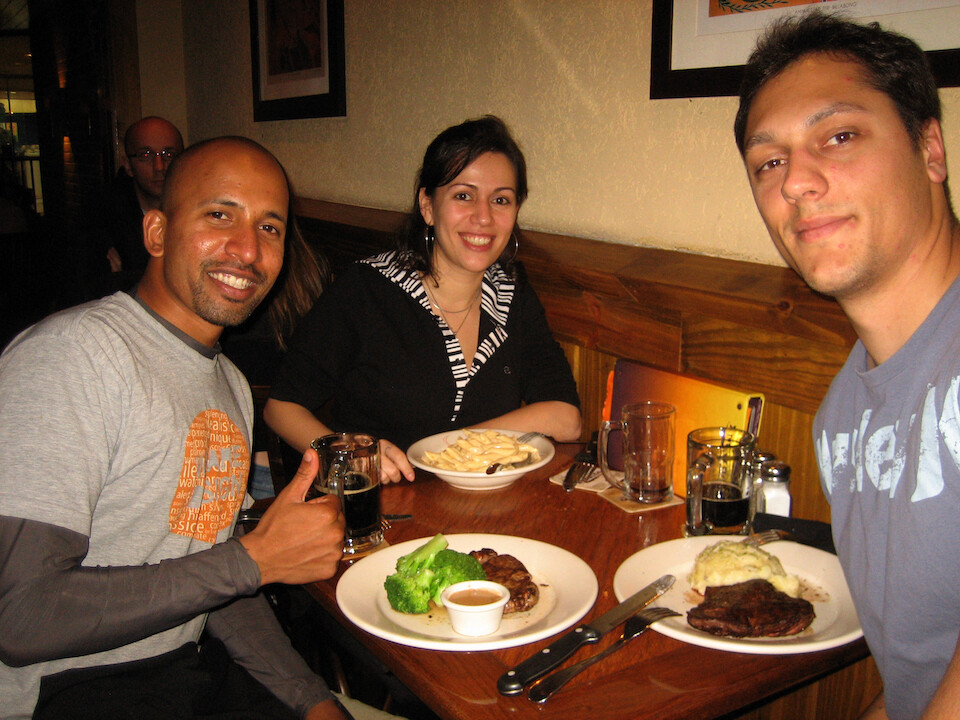
Having lunch at an Outback Steakhouse with Fernando and Luciana, my hosts thru CouchSurfing. They were very gracious to put me up for two weeks while I got everything with the bike sorted out. Fernando is a medical sales rep and Luciana is finishing up a biochemistry Ph.D. They traveled to Europe recently and would like to live in the US for a few years, so I shared some info on that with them.
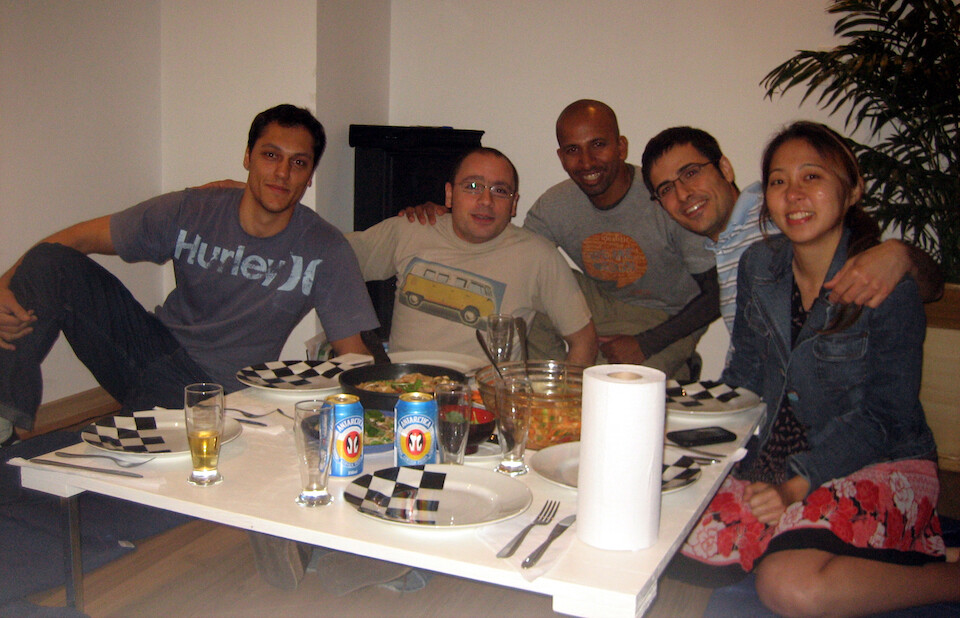
That evening, we were invited by CouchSurfing friends of Fernando for dinner. The two guys are French ex-pat systems engineers, working on a new subway line here and they're both named Julian. To the right is Eliza, a Japanese-Brazilian and Julian's girl friend, who's a journalist. São Paulo has the largest population of Japanese outside of Japan. With the labor shortage in the coffee plantations at the beginning of the 20th century, many rural Japanese families emigrated to Brazil in search of a better life. Along with them, with Brazil's liberal immigration policies in the past, many others cultures emigrated over such as Italians and Lebanese, creating a cultural melting pot in São Paulo. Eliza grew up in a smaller city north of Rio and spoke of how it took a while before she was accepted as a Brazilian by the locals there. But in the mega city of São Paulo, the Japanese are well-established.
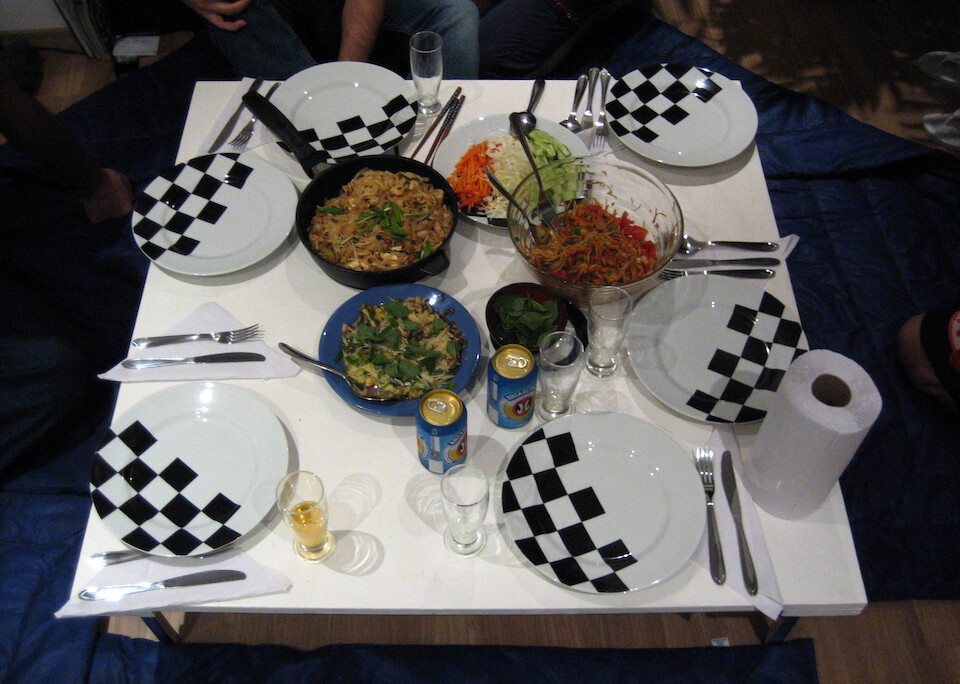
Julian and Eliza are both great cooks and before Brazil, he was posted in Thailand and learnt there how to make the good Thai food that we're having for dinner here.
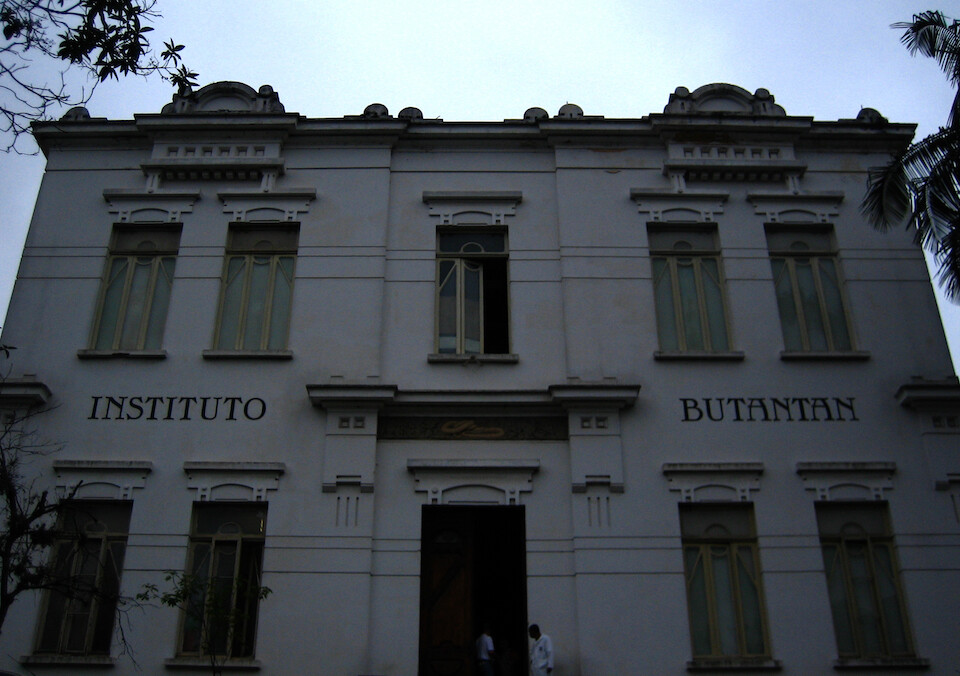
In between my exams, Fernando took me for a tour at the Instituto Butantan, where Luciana is working on her Ph.D on developing pharmaceuticals from snake venom.
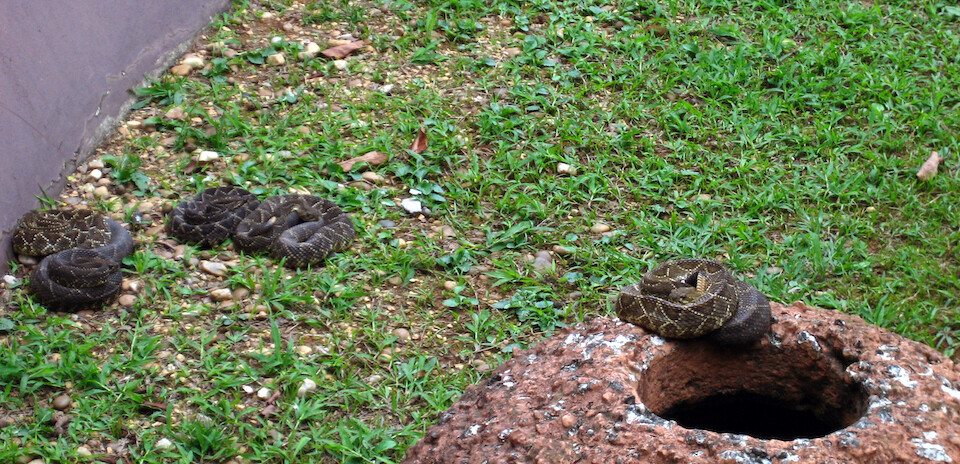
Yup, snakes. All kinds from all over the world. The Butantan Institute is renowned for the production of vaccines and antivenoms and is a leading research facility in venomous animals. It was started in 1901 to combat a bubonic plague outbreak in the nearby port city of Santos.
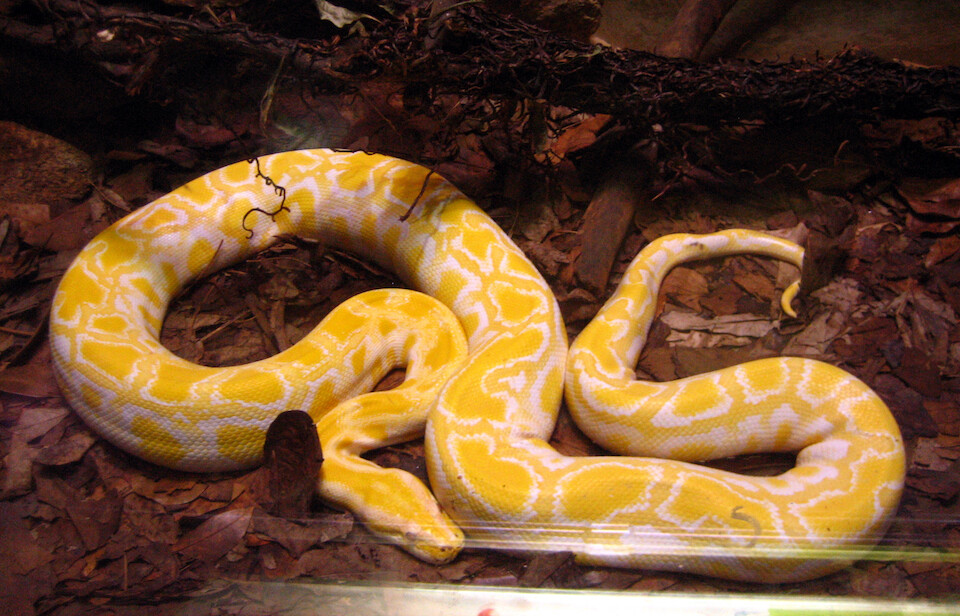
I think I'm a pretty rational guy but I still can't get the societally-installed image (thru movies and our media) of snakes as evil and dangerous out of my mind. I've conquered a lot of my fears over the years, but haven't yet got around to this one.
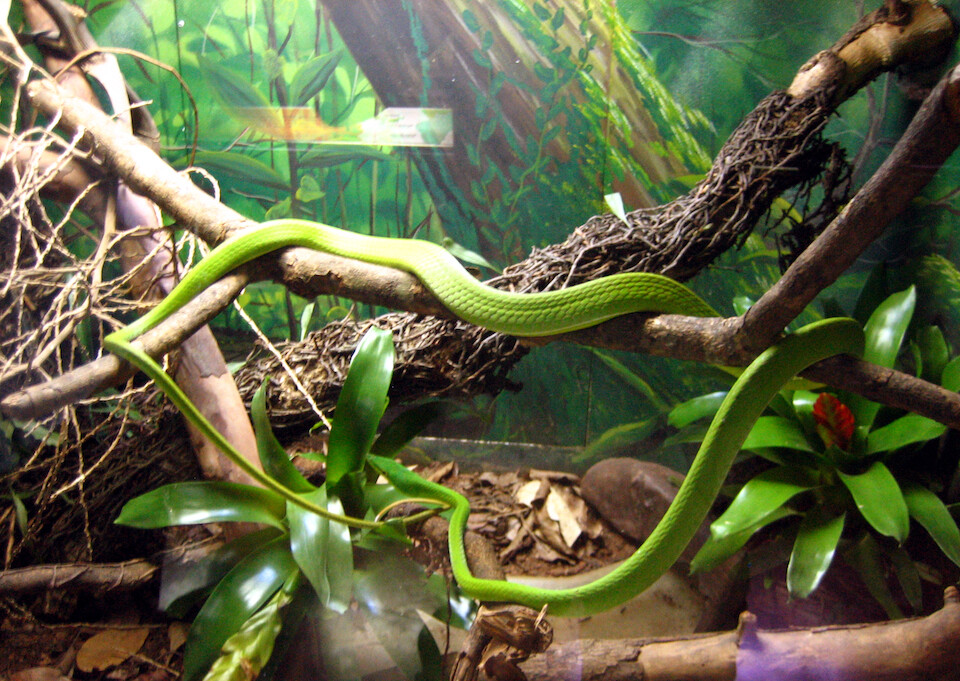
A green tree snake. Fernando pointed out that the triangular-shaped head snakes are usually poisonous but not always.
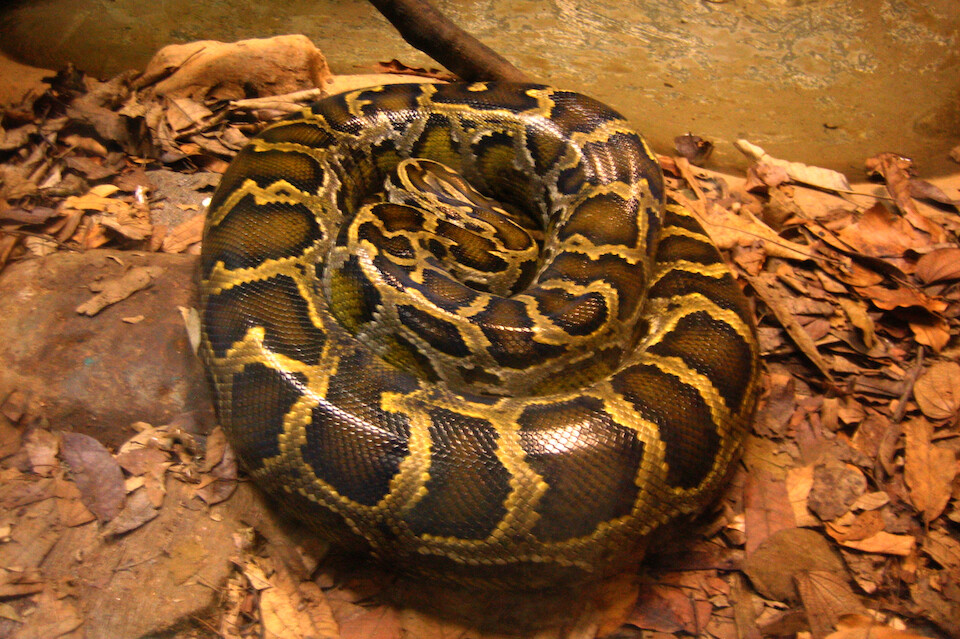
The king of the hill here, the Indian Python. It's not poisonous but is known as a constrictor, meaning it crushes its prey to death, then swallows it. They didn't have an anaconda in the display cases; it would have been nice to compare the two. After seeing some deadly spiders and tarantulas, I was happy to leave before any of the inmates escaped.
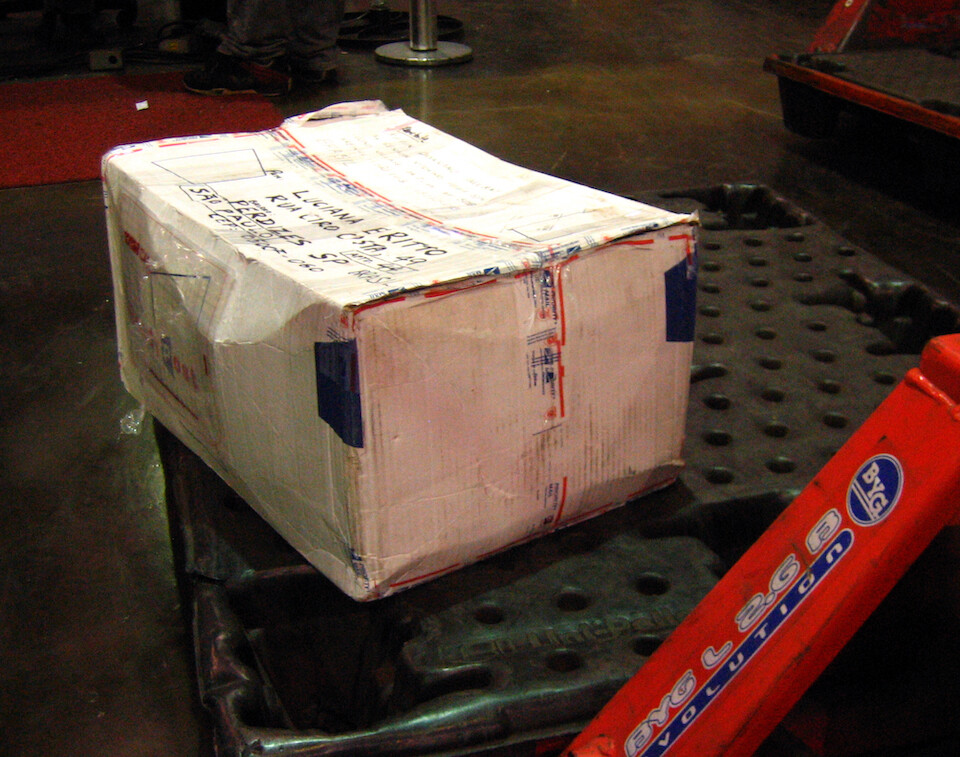
Receiving a care package from my sister in Miami with a new clutch kit, a new tent from Catoma, some new tool tubes and various other items. This box traveled all over Brazil before I finally got my hands on it. It arrived into Rio (two weeks from Miami) and cleared customs there (surprisingly, I didn't have to pay any customs duties) then it was sent to Kavin in São Luís, but it was too late for me, so he sent it down here to São Paulo. I also got a fresh supply of spices from my mom.
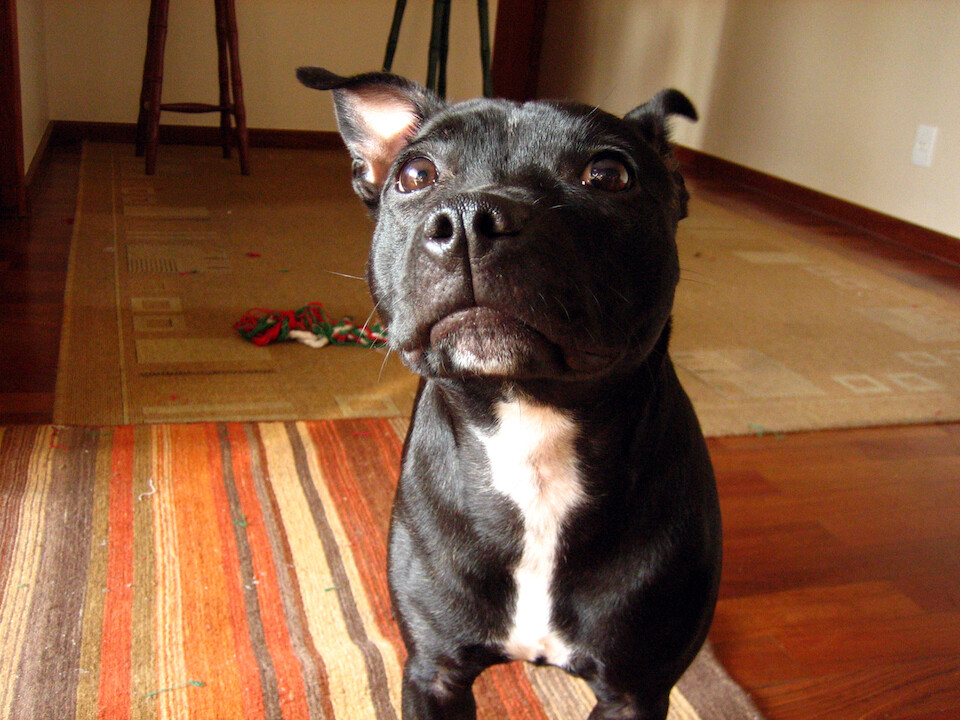
This is Buma, Fernando and Luciana's Staffordshire Bull Terrier puppy. She was fun to play with and reminded me of Zoey, a pitbull I lived with in Chicago. One aspect I really enjoy of staying with people in their homes is meeting their pets and see what their lives are like.
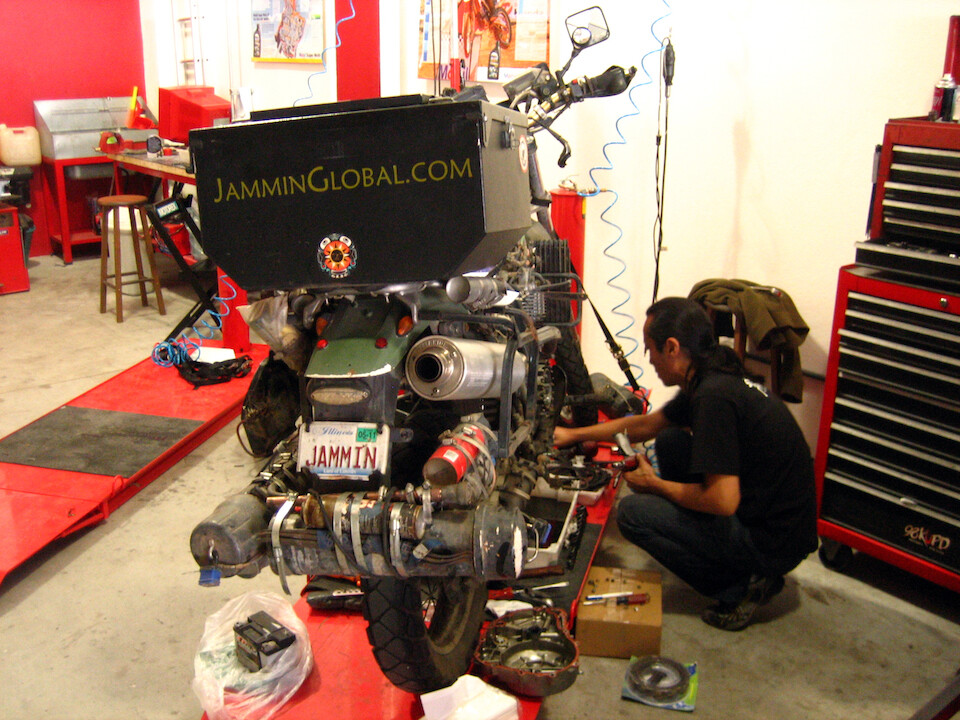
Once my exams were over, it was time to focus on sanDRina. A cousin of Luciana's put me in touch with Rogerio here.
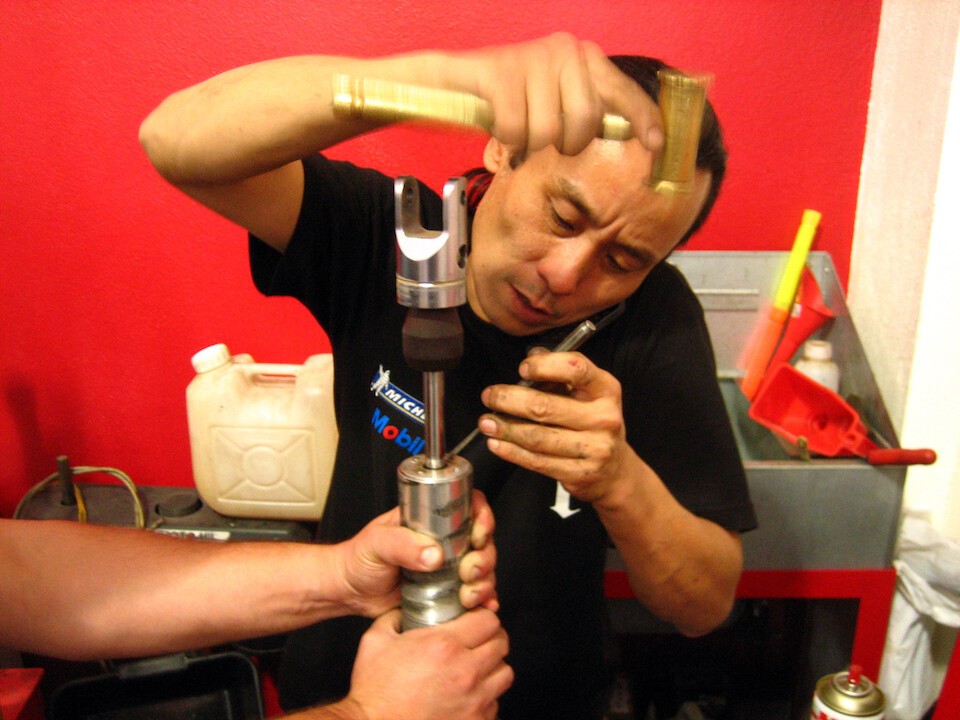
He's a Race Tech Suspension, KTM and Honda certified mechanic and perfected his skill in Phoenix, Arizona for many years before returning home to Brazil. He also raced in the Rally dos Sertões with the factory KTM team and had some good stories to tell. I wasn't having any issues with my suspension but after coming across such an experienced mechanic, I figured a rebuild would be good and I knew I could trust him with the prized bits of sanDRina.
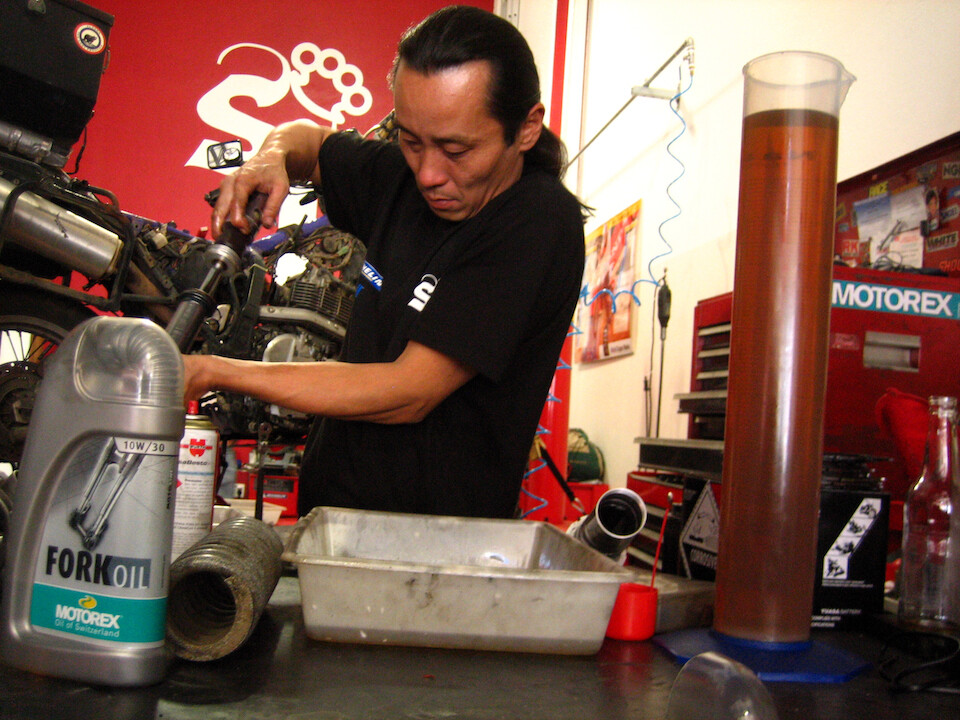
It was a good call to rebuild the rear shock as I haven't done so since buying the bike and putting around 50,000 kms (31,000 mi) on it since then. It's a Larry Roeseler Signature Series 420 shock and Rogerio said there was very little oil left and the nitrogen from the bladder had all but leaked out. He put in some good quality Motorex shock oil and said the rest of the unit looked good. The shop we're at is called Street Fighters and they're new on the scene but are quickly creating a good name for themselves.
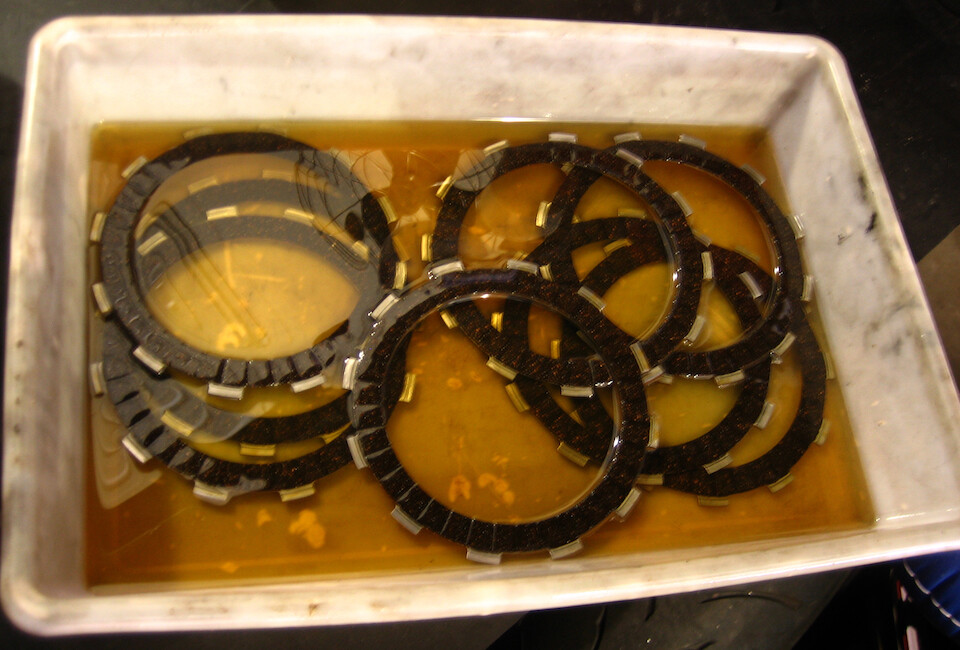
The clutch problems that started back in Bolivia were finally being put to rest with this new EBC Heavy Duty clutch kit from ProCycle. The fibre plates are soaking in engine oil before installation.
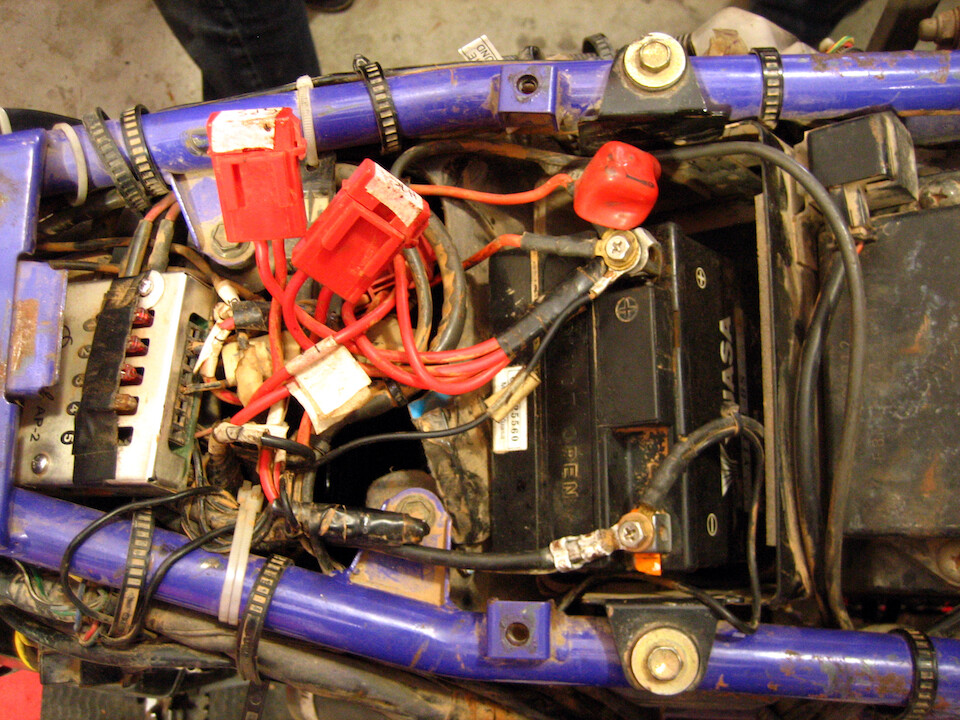
This was the little battery that the mechanic gave me in Cambui to get me here. It did really good and Rogerio joked that I should carry it as a spare. It was replaced with a new Yuasa battery.
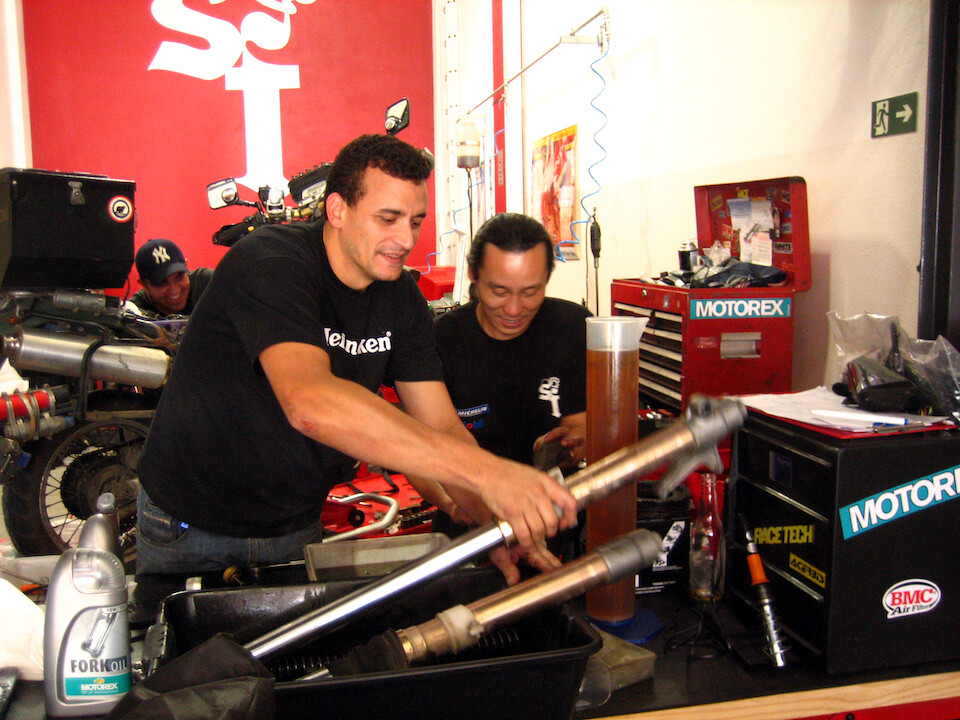
The front forks being rebuilt. The seals looked good, so the oil was changed and the Race Tech Cartridge Emulators were also rebuilt. The valve springs in the emulators had busted through the housing after probably hitting a few pot holes on the TransAmazonica too hard. My WER steering stabilizer was also rebuilt with fresh oil. That's Andreas, Rogerio's right-hand man who worked with steady precision. His ride was a DR800, knows as the DR Big.
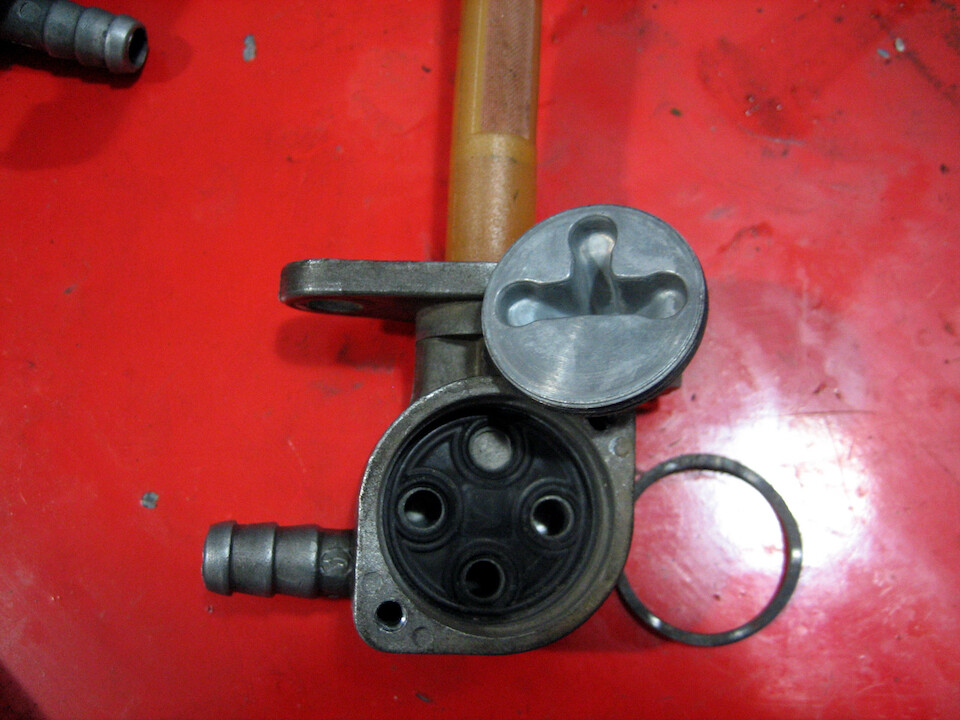
Rebuilding the fuel petcocks on the Aqualine Safari tank. The alignment of the holes with the path in the key determines if you're running on reserve or normal.
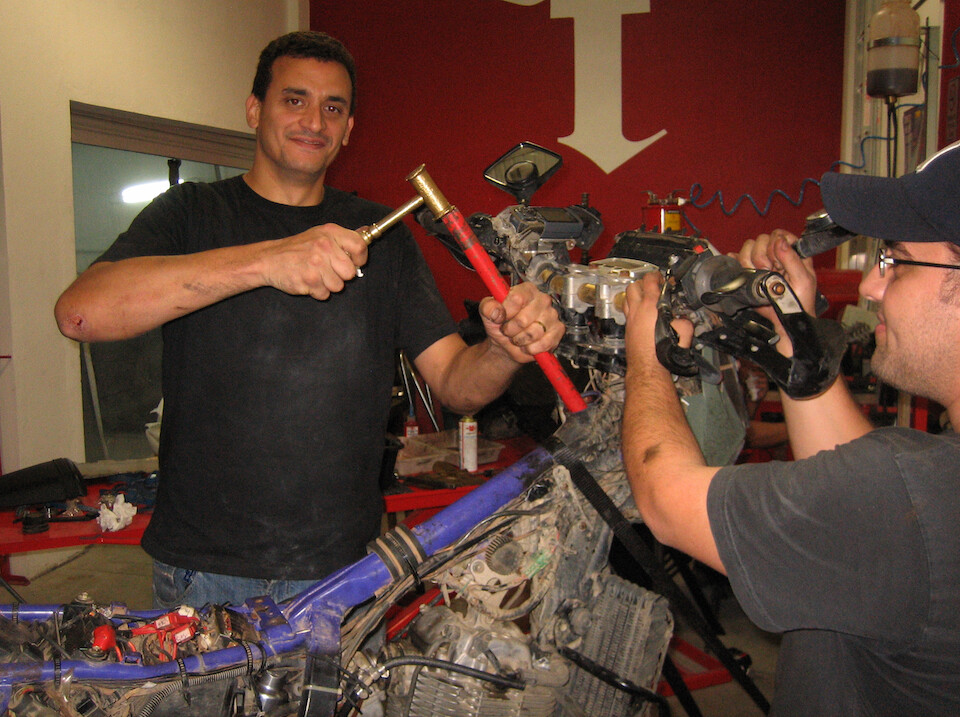
I had noticed a notch in the steering and Rogerio confirmed that the bearings were shot. Andreas is whacking out the old steering head bearings that were put in before my Continental Divide trip.
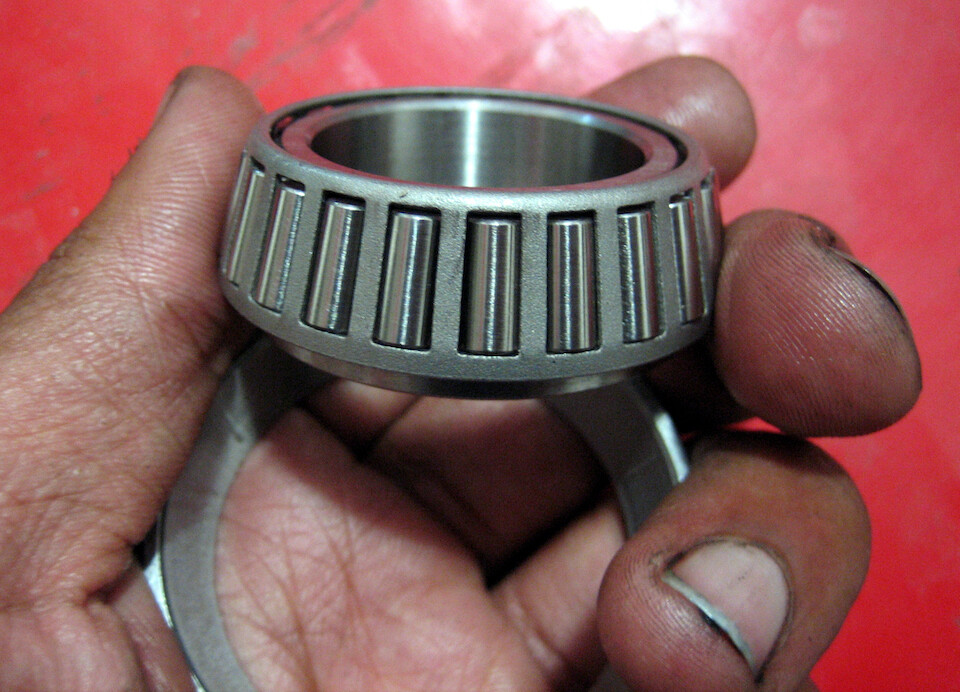
I wasn't so keen on All Balls bearings after the rear wheel ones failed on me in Peru, but that's all they had in São Paulo and I was happy they were able to find the specific bearings for my bike. The rest of the guys at Street Fighters were top notch as well and were running around town getting whatever I needed for the bike. It was a good place to be.
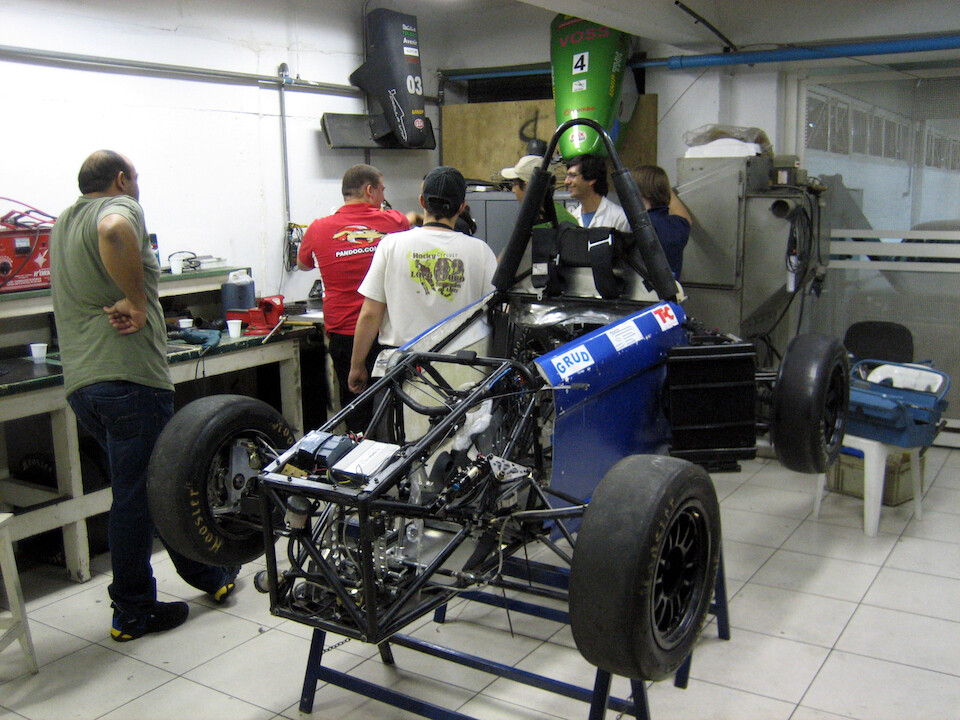
As we were working into the evening, a few guys from the next door univeristy (UNIP) came over and asked for Rogerio's help. Turned out they were part of the Formula SAE program, where college teams engineer and race a mini formula race car against other colleges in a performance and design competition. Formula SAE was my life during my undergrad at Purdue's Mechanical Engineering and that's where I learnt most of what I know about wrenching on cars and bikes. Before that I didn't know how suspensions or differentials worked. I was also introduced to machining there, spending entire weekends over a lathe, turning out bespoke parts for the car. The ultimate reward was getting to be the test driver over the summer; pulling g-forces is an awesome feeling.
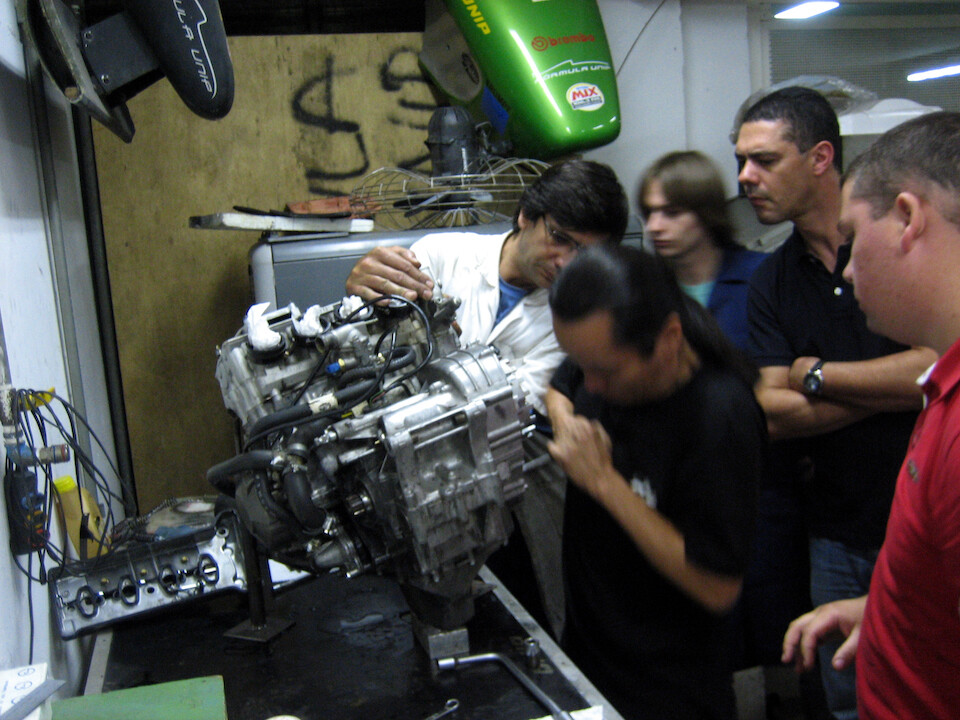
They just rebuilt their engine (from a Yamaha R6) and were having some issues with the transmission. The formula dictates the engine size to 600 cc, which means most teams use a sportbike engine. On my team, I was responsible for the heat exchanger and fuel delivery systems. This team was having some issues with over heating and asked me a few questions on it. I had designed a water spray system for our car to take advantage of evaporative cooling, but the added weight wasn't justified. I still would like to design such a system for the DR - one of the things I didn't get around to before leaving on the trip.
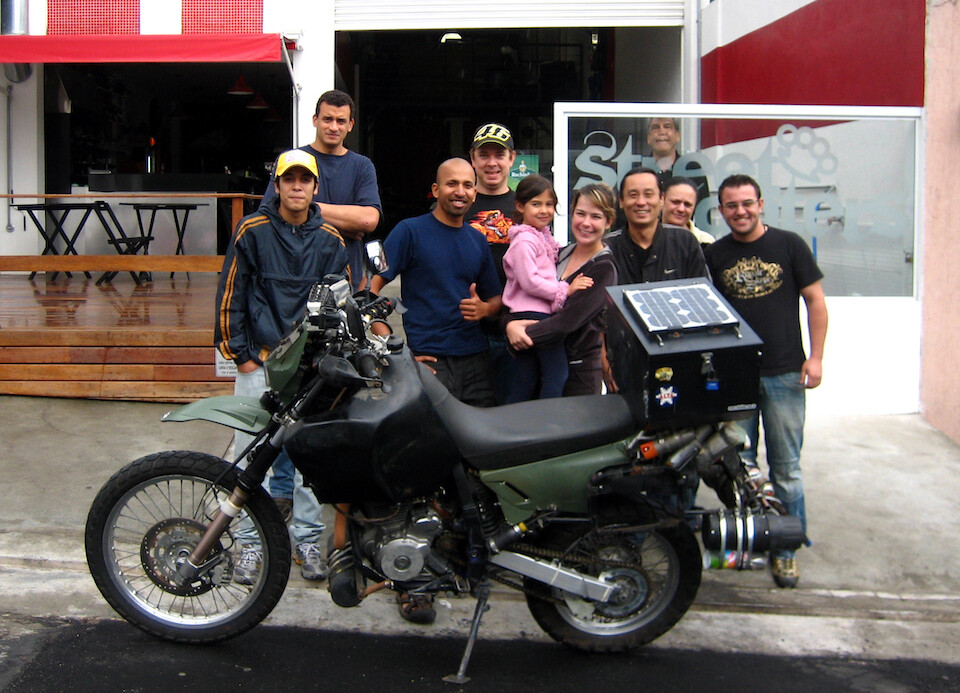
sanDRina with the whole crew at Street Fighters. I was done with Round 1 and would soon be back for more.
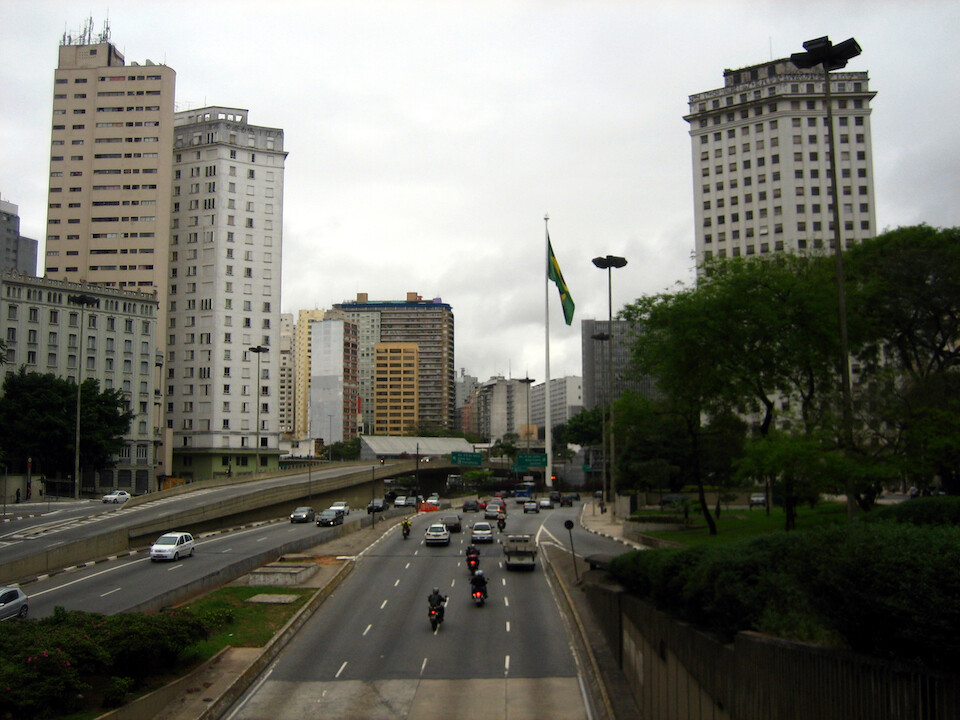
Going for a test ride around the city. São Paulo is a modern city and parts of it feel like New York and other parts like San Francisco (lots of hills). It's the biggest city in the southern hemisphere with a metro population of around 20 million. It's considered an Alpha World City, being an important node in the global economic system. There's not too many touristic things to do, but it's a great place to get things done.
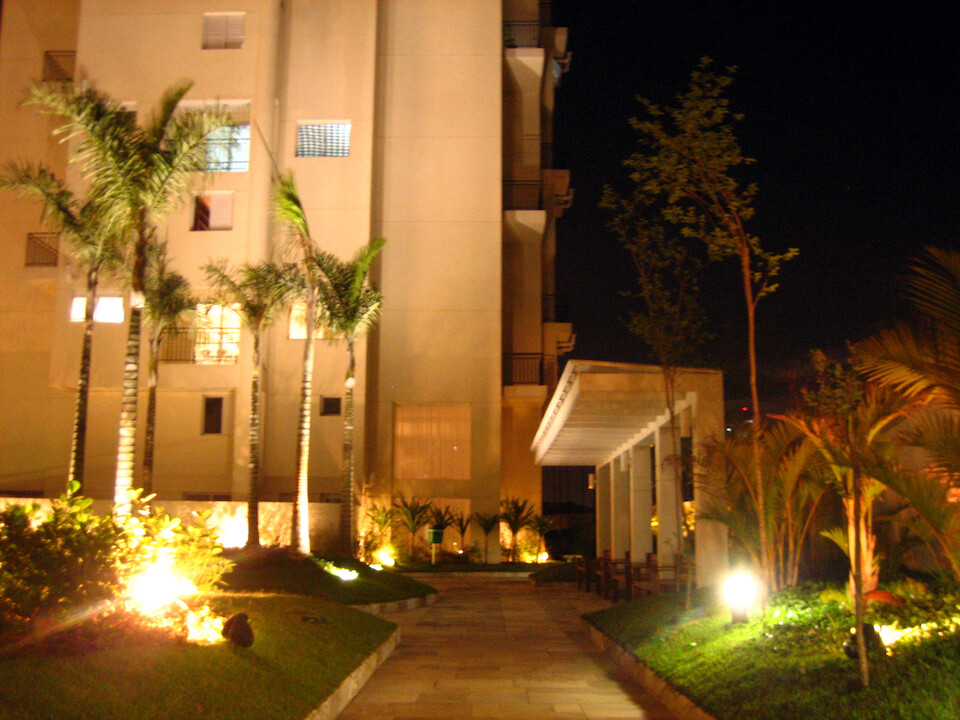
Fernando had to go away on a business trip for a few days, so I stayed with Julian in his well-secured apartment block. São Paulo is very progressive, but crime is still a big concern and most residences are secured like fortresses.
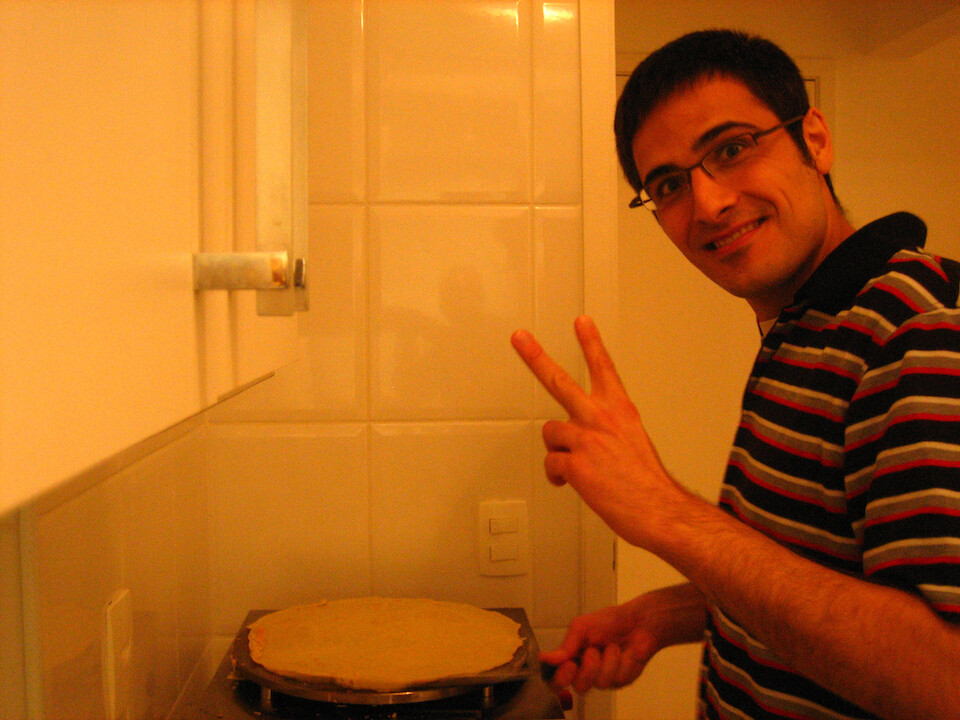
Julian, being French, moves around with a crepe-maker.
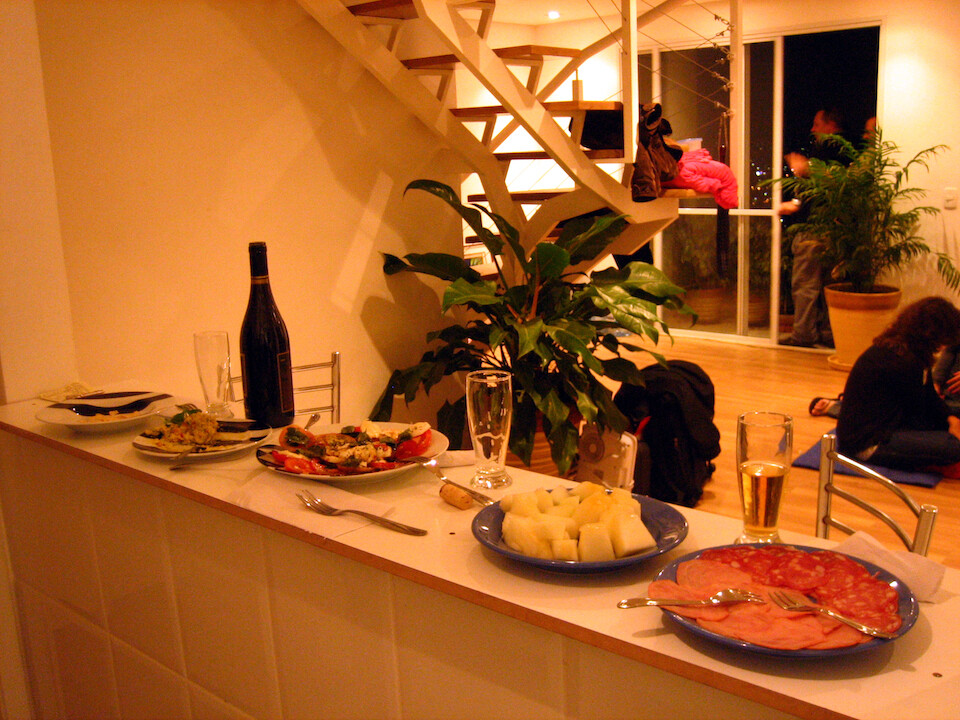
Reminding me of my life in Chicago - he likes to throw frequent get togethers centered on food.
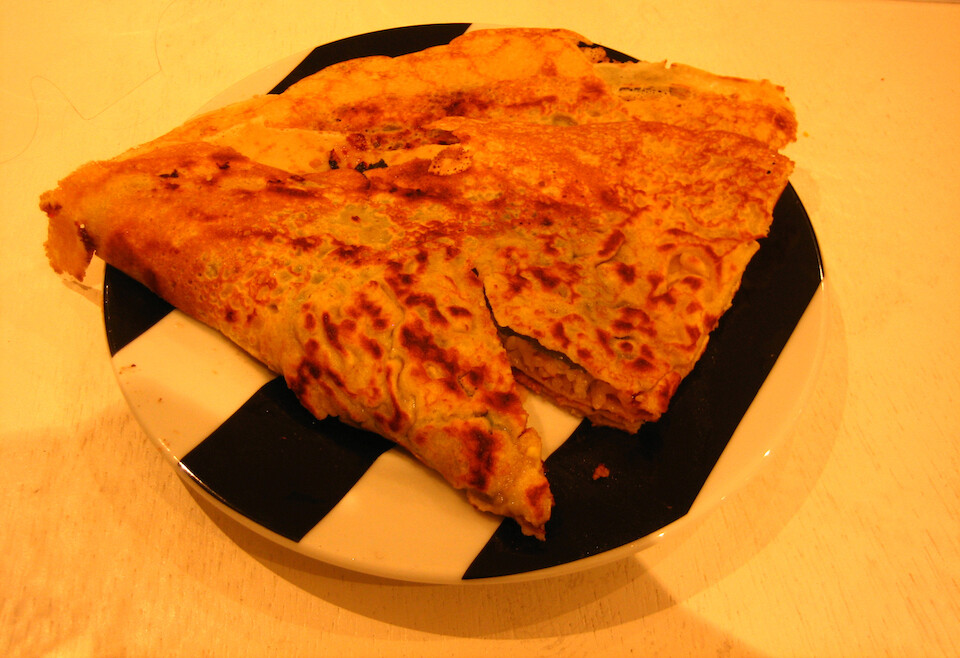
He made all sorts of delicious crepes including the staple Nutella and banana but I requested a special kind here with this Thai chilly paste (which was kind of sweet) with rice. Strange, but it tasted yummy.
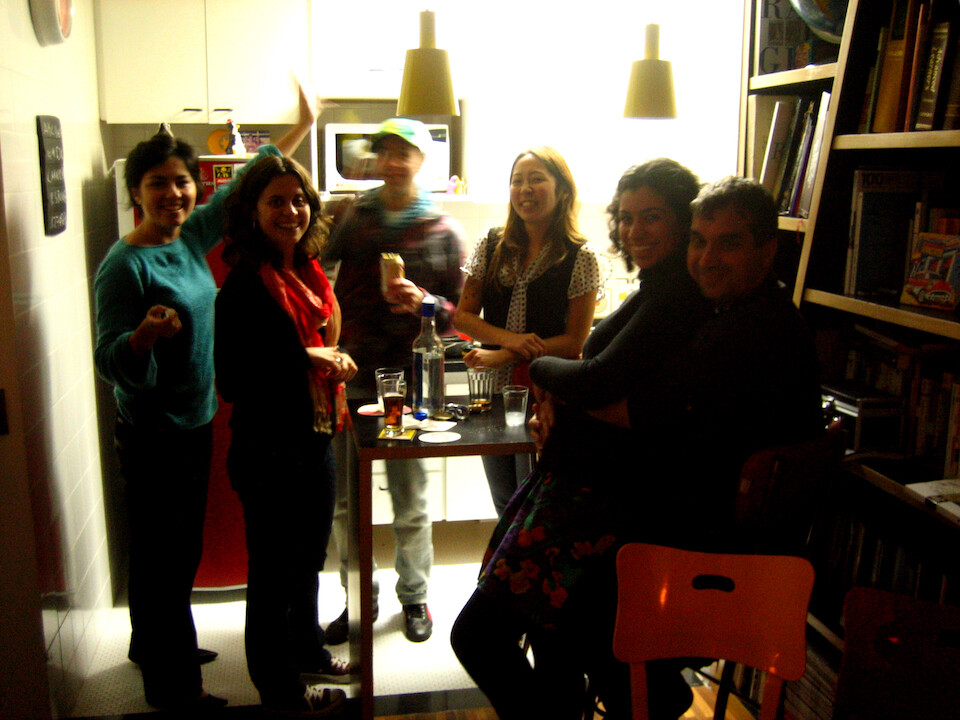
At the crepe party, I met Bianca (with the red scarf), one of Eliza's journalist friends and she asked if I could make my chicken curry for a party she was throwing the next night at her place here. You betcha. This is at Bianca's place and more of their journo friends.
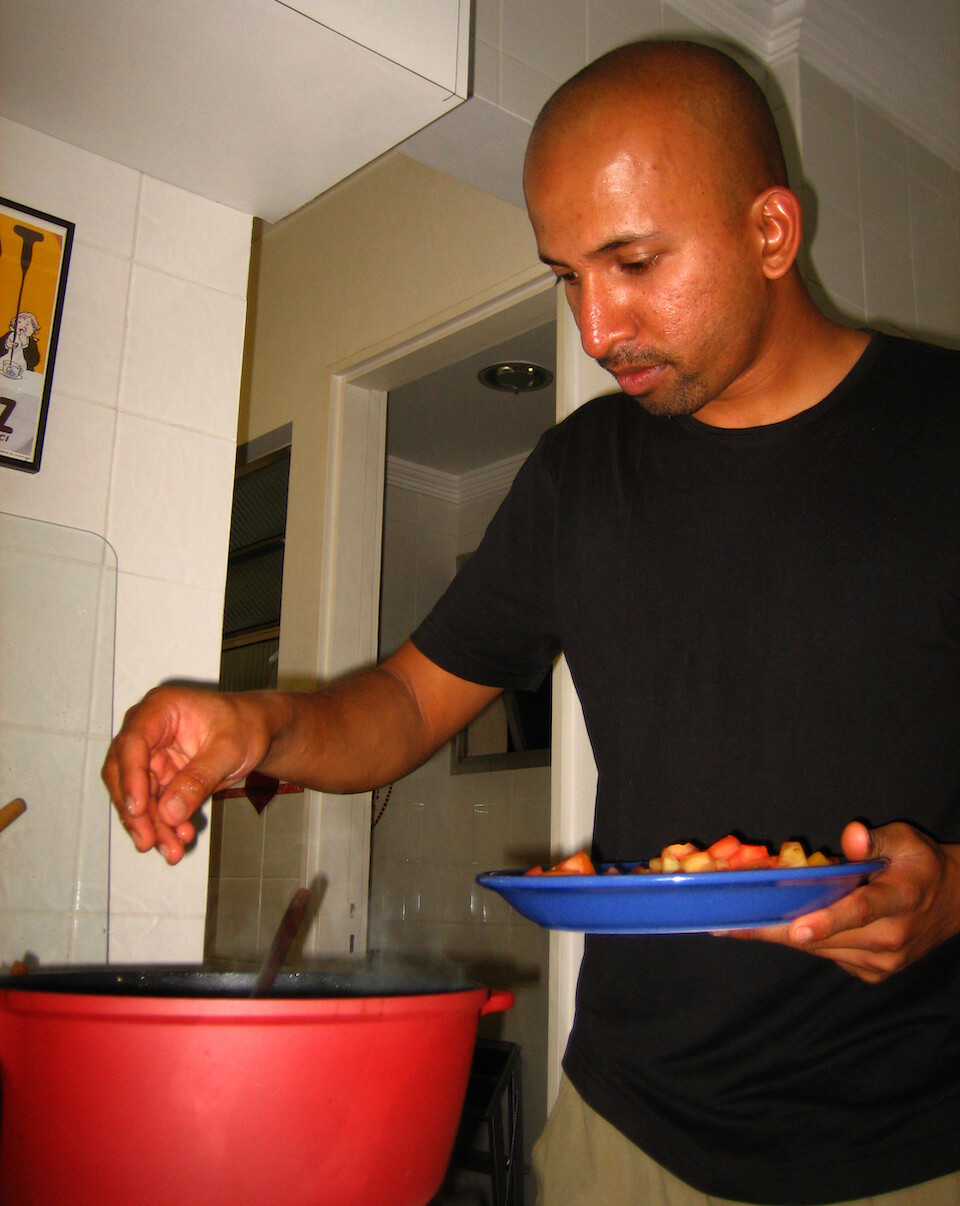
I love coming into someone's house and going straight to their kitchen. Bianca asked what I needed the night before and had all the ingredients ready. Here, I'm slowing adding in the chopped tomatoes to get the sauce out of the curry.
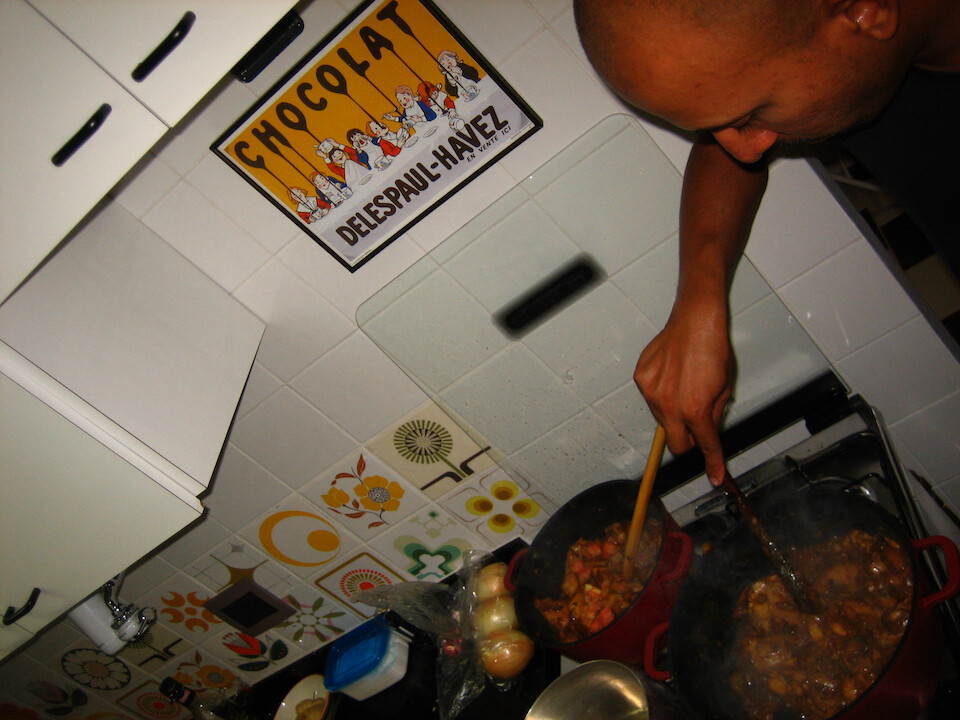
I usually make my curry not very spicy due to the sensitive taste buds of South Americans but on request, I made a separate dish that was more spicy.
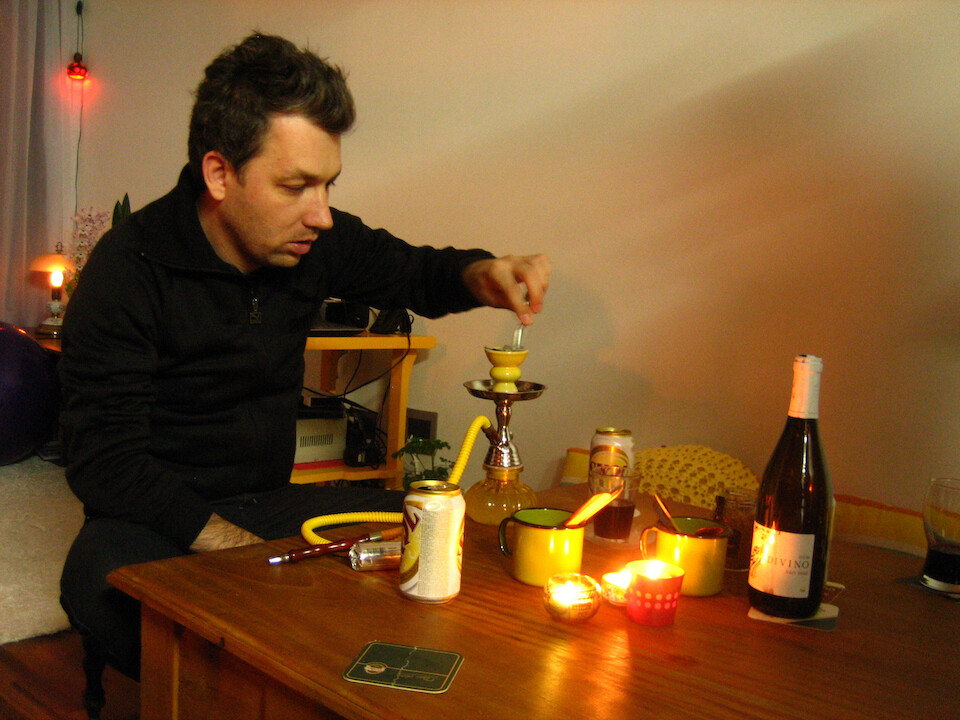
Fernando getting the hookah going, which is an Indian waterpipe for smoking tobacco (usually flavoured), which is gaining popularity around the world. I'm not a tobacco smoker, but if it's filtered through water and chilled in the same process with a bit of flavour thrown in, it's not bad at all.
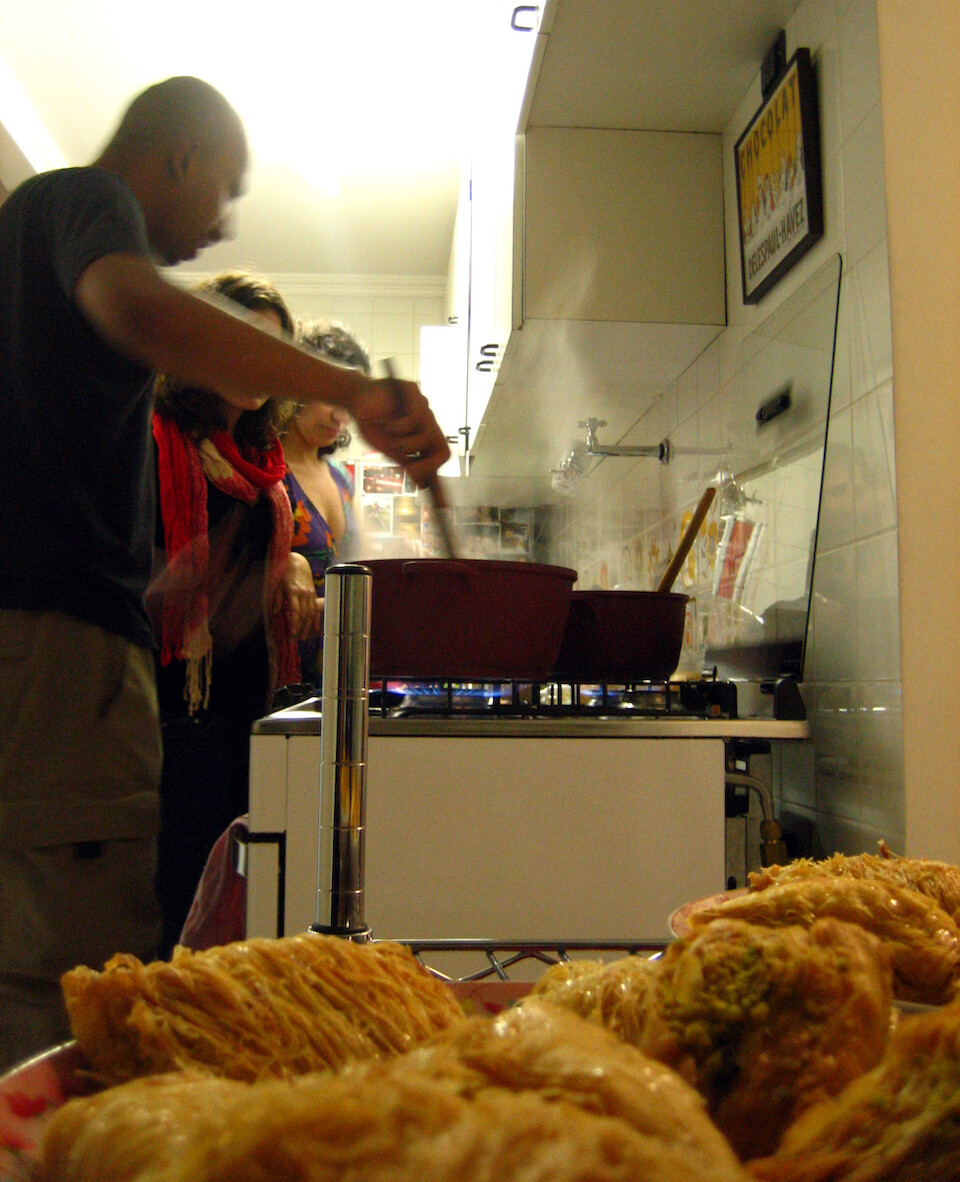
A shot from the desert tray of baklava (a Turkish pastry) towards the waftings of the Indian curry. Bianca's traveled around and was pleased at the aromas in her place.
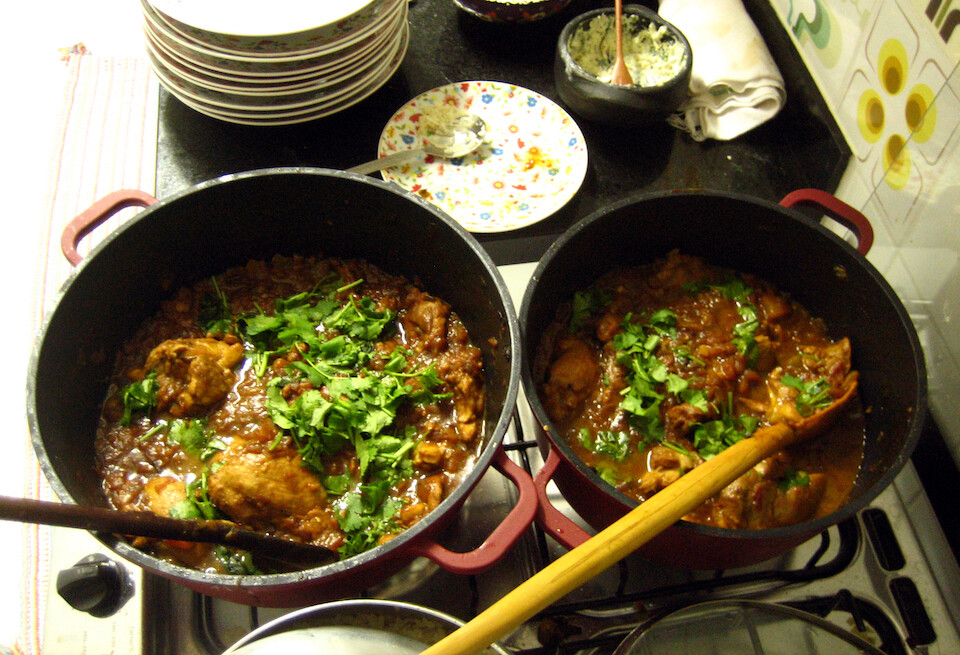
Seasoning the curries with freshly chopped cilantro. I was pleased to see more people went for the spicier of the two curries.
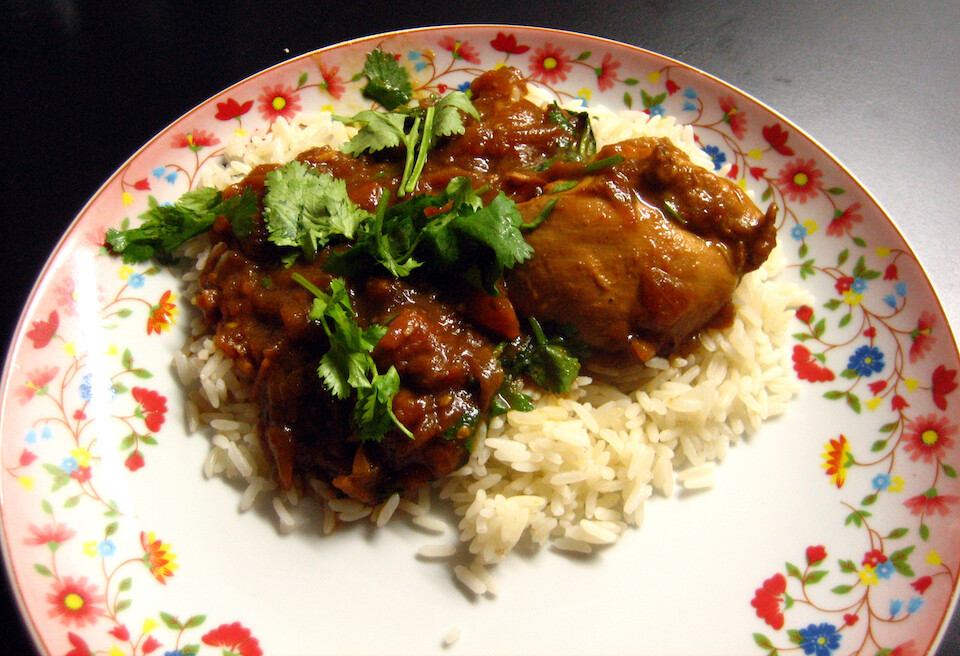
If you've been following the trip, you're probably aware that I'm making the same dish all the time. Many reasons for this: the ingredients are simple and easy to source anywhere, plus with a new audience every time, it's still new and novel to them. Also, I've read that success in anything comes with many, many hours of practice, so my curry keeps getting better all the time.
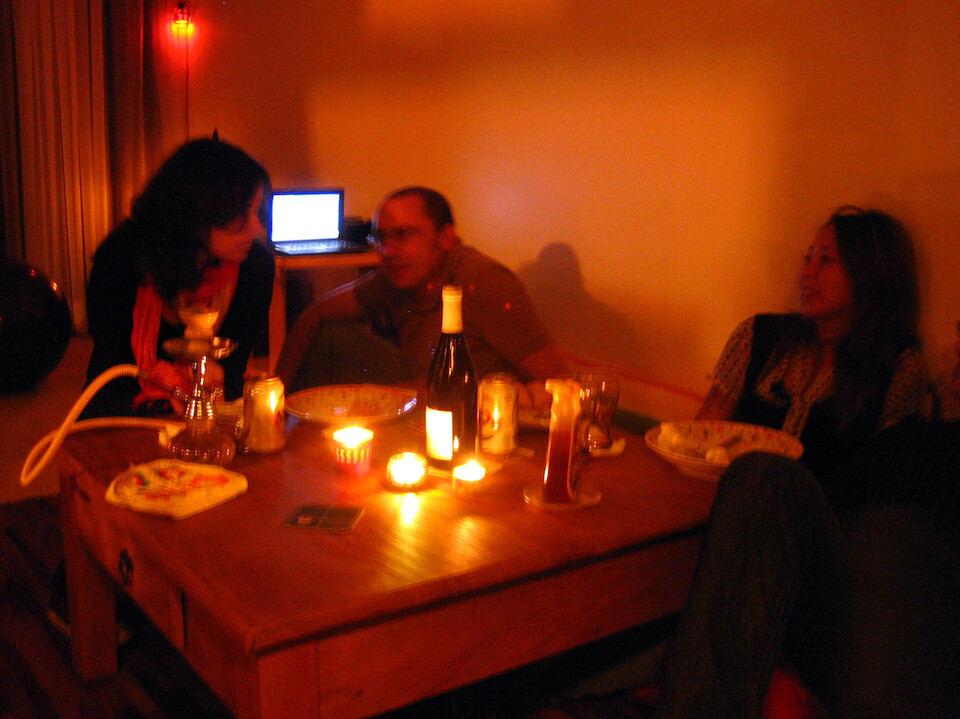
Stuffed with curry, the diners laze around the low table, taking puffs from the hookah.
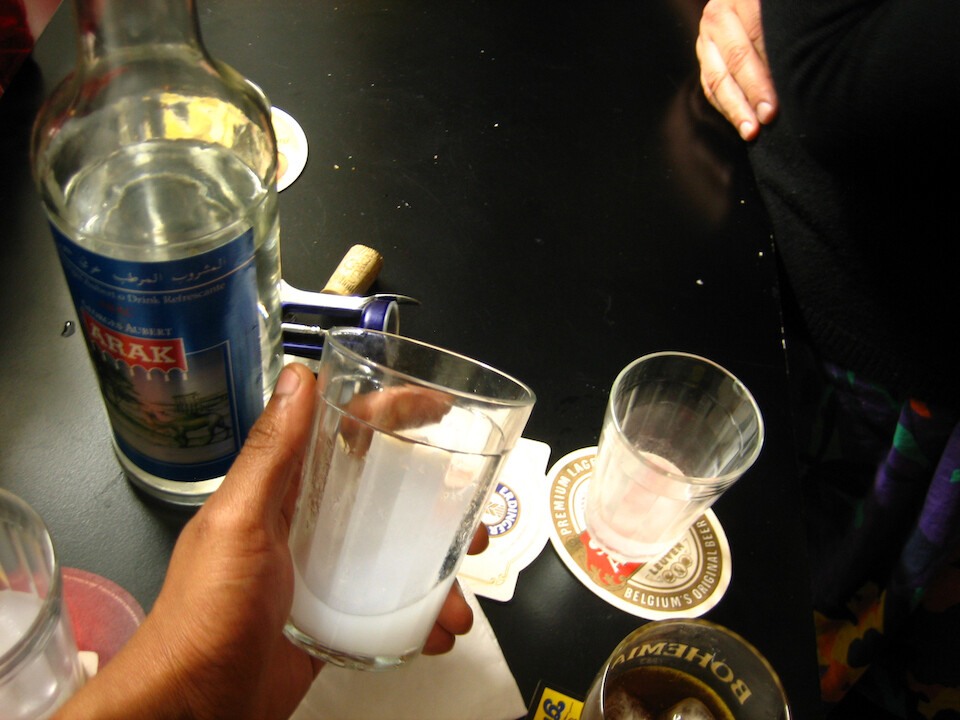
Having a drink of Arak, an anise-based liqour, which acts like a digestive.
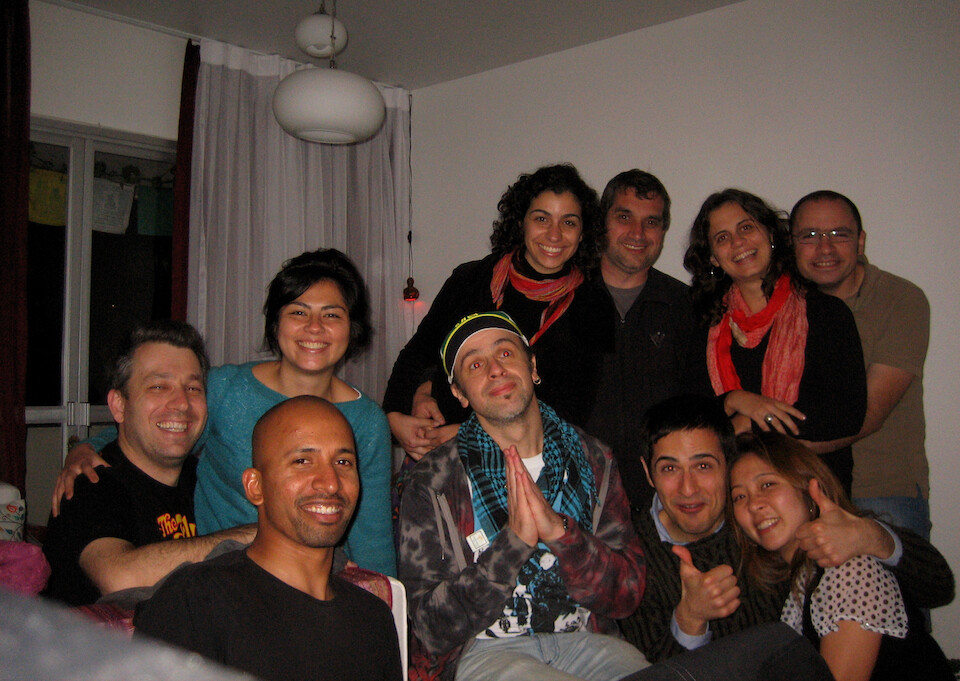
Sharing a wonderful evening with warm Paulistas over some Indian food.
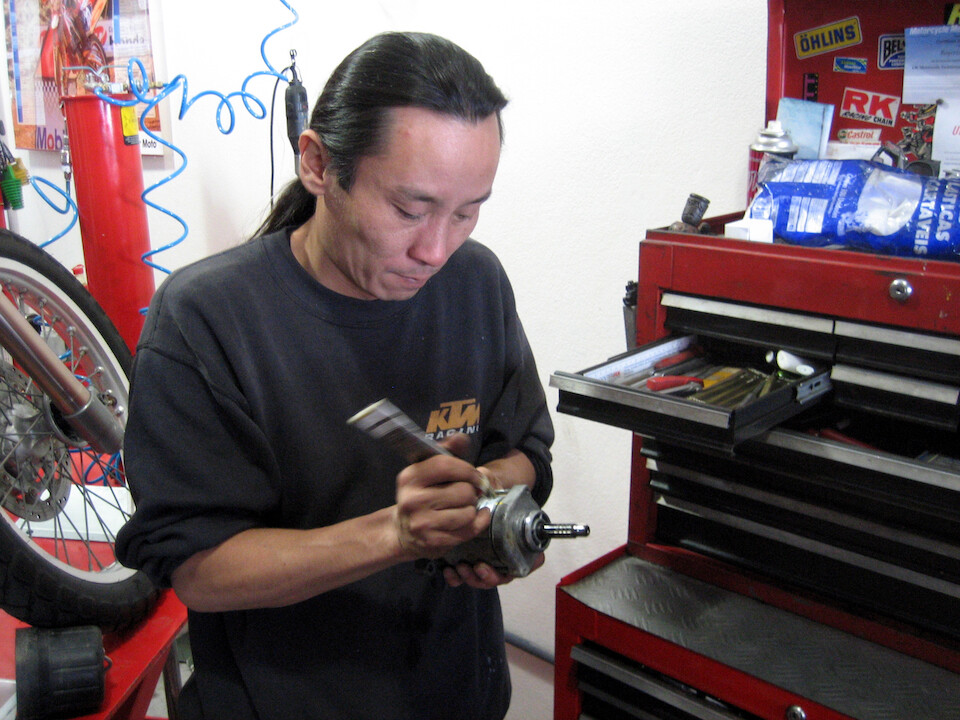
After a long weekend, it was back to Street Fighters to take care of some long-term maintenance issues.
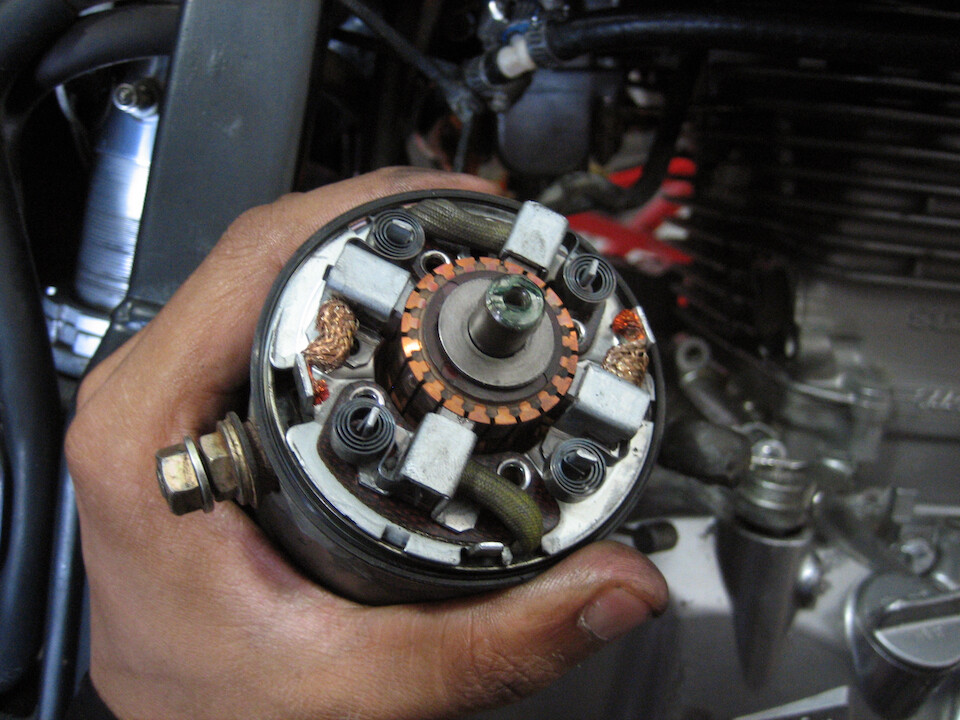
Giving the starter motor a good cleaning. Everything checked out all right. We also tested the whole charging system: the generator, the rectifier and inspected the wiring loom.
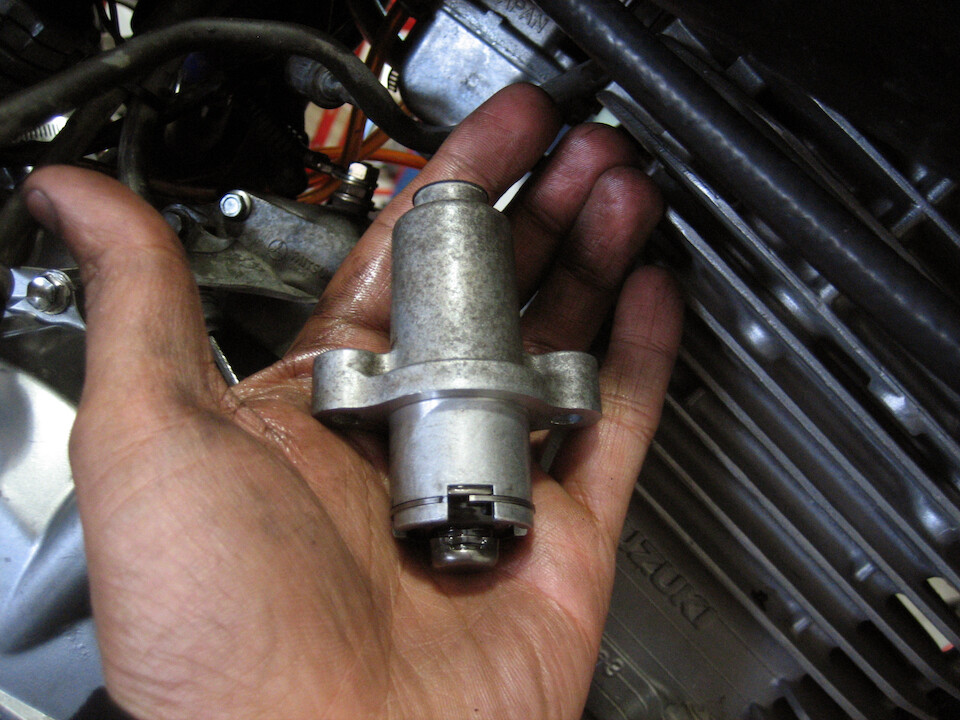
We had to remove the Cam Chain Tensioner to remove the starter motor and if you remember from way back in San Francisco, the mis-assembly of this part was the reason I destroyed my original engine. I expressed my reservations to Rogerio about messing with the tensioner and he assured me that he would show me exactly how to reinstall it the proper way. I released the tensioner with the correct tension on the cam chain and nothing broke this time. I liked Rogerio's philosophy as a mechanic. He said a motorcycle is simply a machine and if everything is working perfectly, you should be able to disassemble and reassemble every part of it with no issues. Of course, you must have the knowledge of how to do it and enough experience and wisdom to guide you through it.
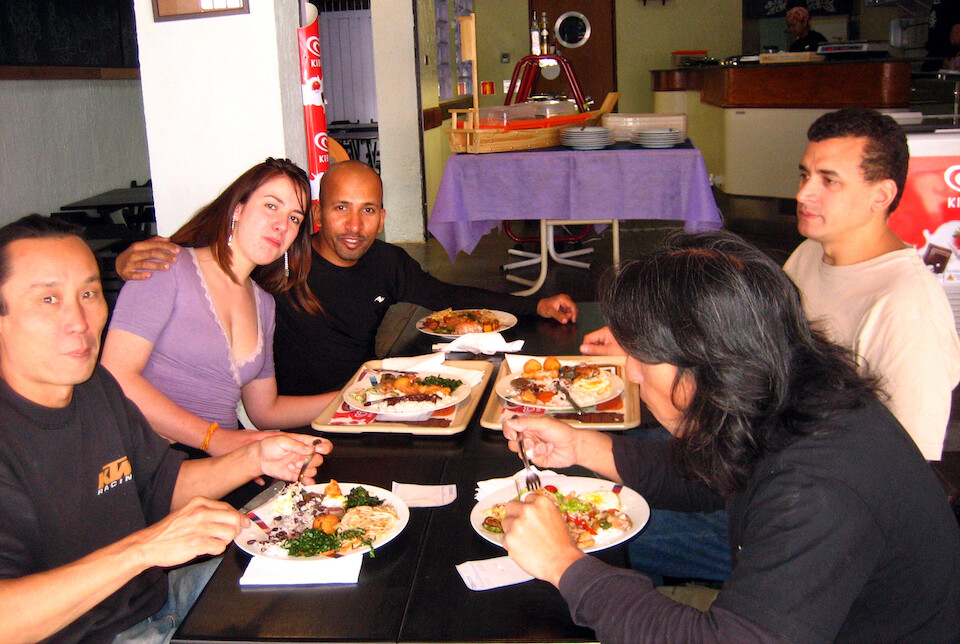
Having lunch with the Street Fighters crew at the next door Japanese por kilo restaurant. Unique to Brazil are the normalcy of restaurants that charge you by the weight of the food you take from a buffet line. This definitely helps cut down on food waste as you will only take what you can finish. Cheaper restaurants charge around R 10/kilo (USD 2.50/lb) for the regular fare of rice and beans with some meat up to fancier restaurants like this one with sushi and tasty Japanese dishes for R 20/kilo.
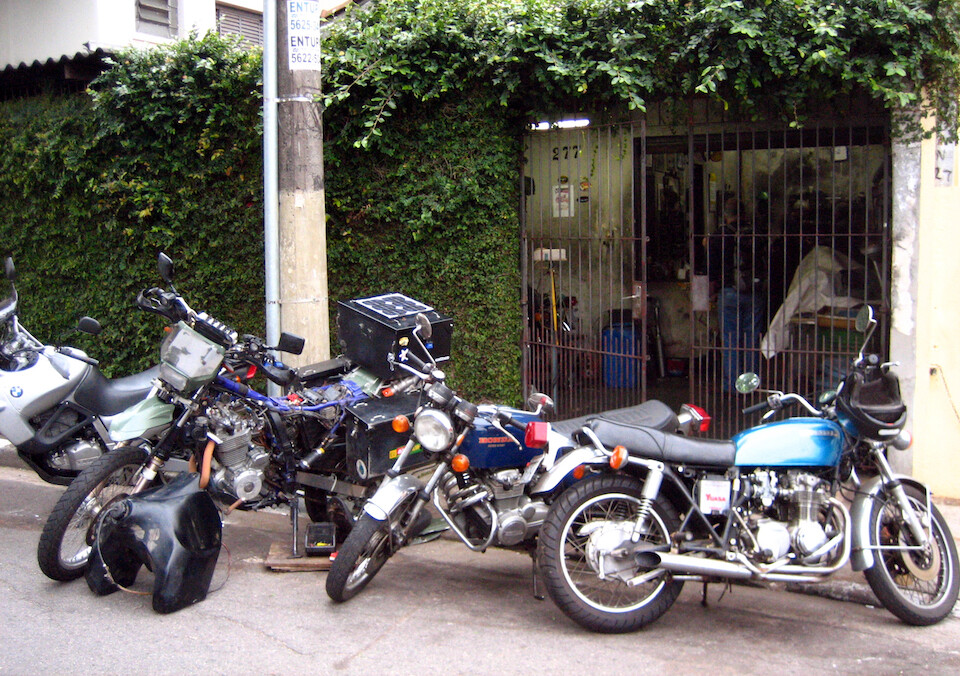
One of the issues I couldn't solve at Street Fighters was my jet needle problem. We couldn't find a spare that matched my needle exactly after scouring most of the moto shops in town. Rogerio sent me to Roberto's shop here. He's a specialist mechanic doing custom jobs on older motorcycles.
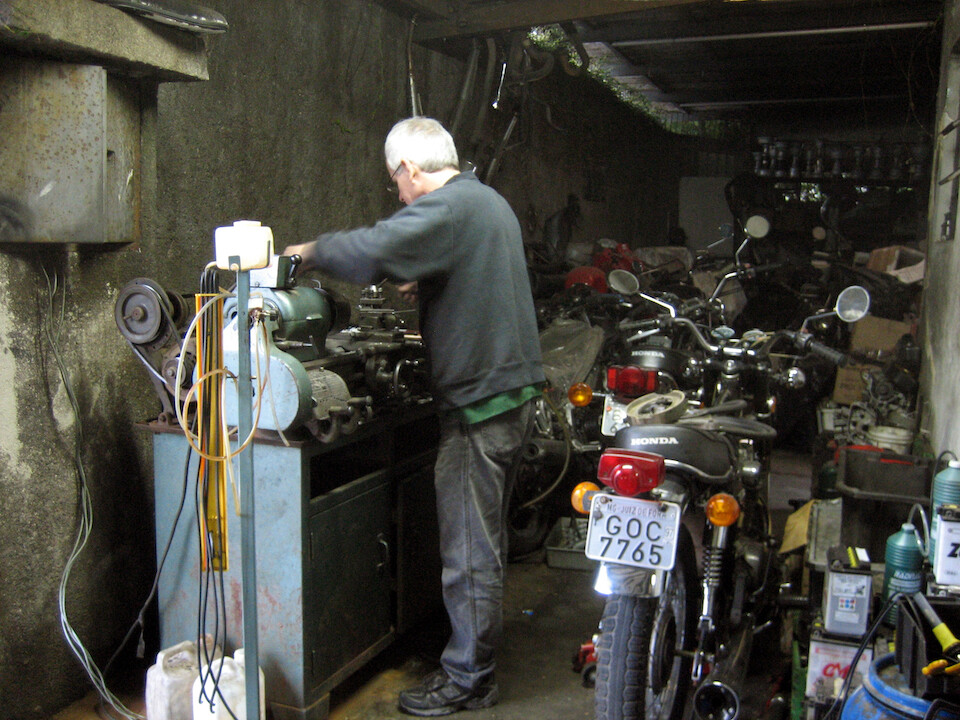
Roberto's engine expertise has been called on by the state oil company, Petrobras for designing and machining some parts for oil rig pumps. I explained my problem to him and he went about devising a solution.
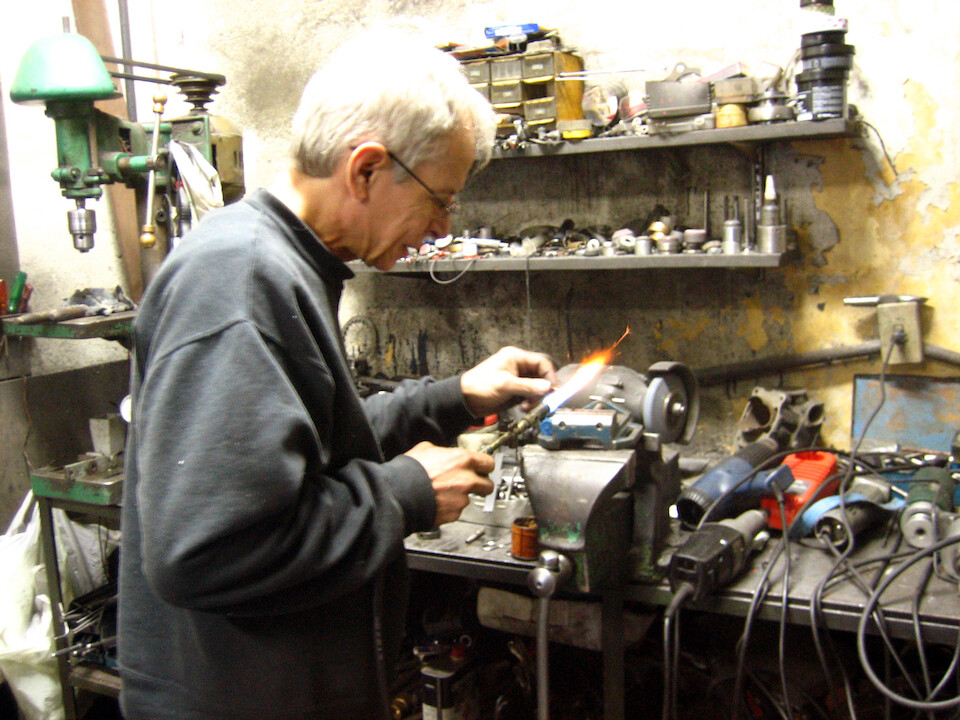
The problem with my jet needle was that it was too short, therefore the carburetor was running rich. We couldn't find a spare at his shop, which had engine parts lying all around, so he figured it would be best to mate on the additional piece that was broken off.
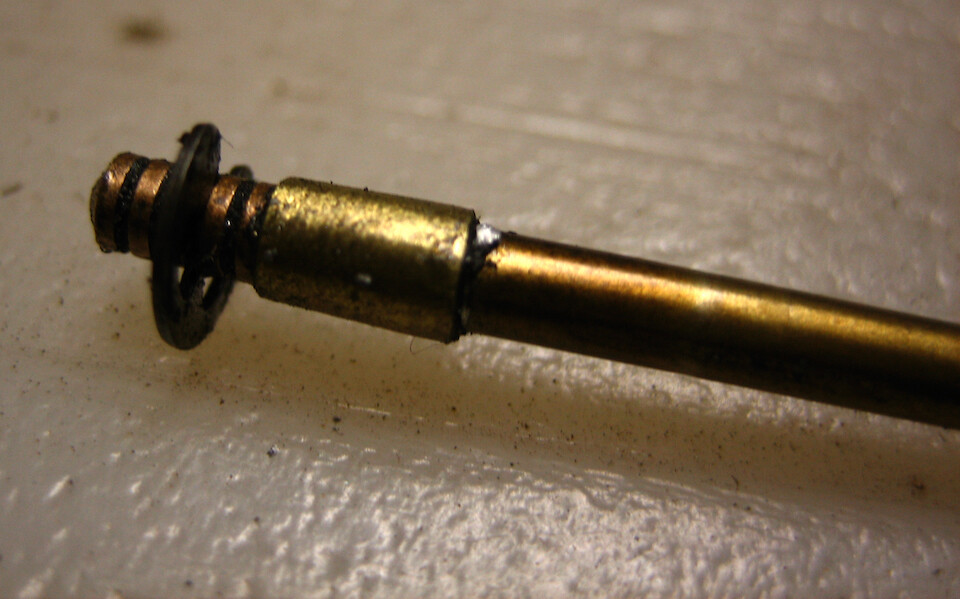
The jet needle with a new head, secured on with a collar, which was soldered on, but being brass and aluminum, it was hard to get a good mate. I installed it in the carburetor and the engine was sounding good again, but this issue wasn't closed yet. The next day, while riding around town, the collar came loose and the needle fell into the carburetor, making the bike run terribly.
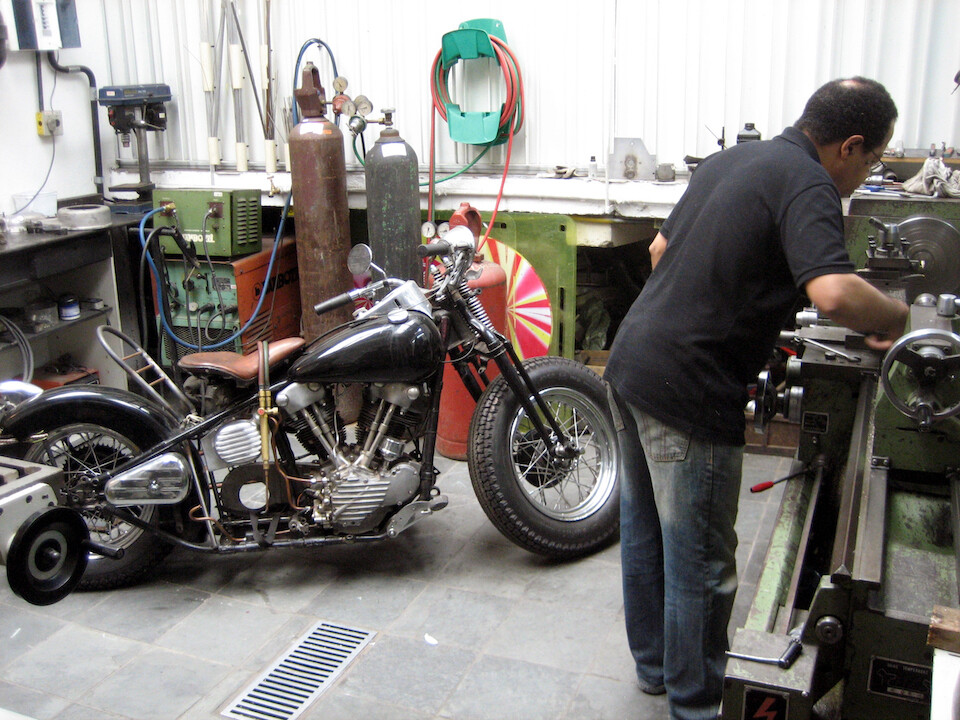
I limped the bike across town to Rogerio's next contact, Paulo, another motorcycle machinist who's worked on setting up race bikes, along with vintage ones like this hard tail Harley here.
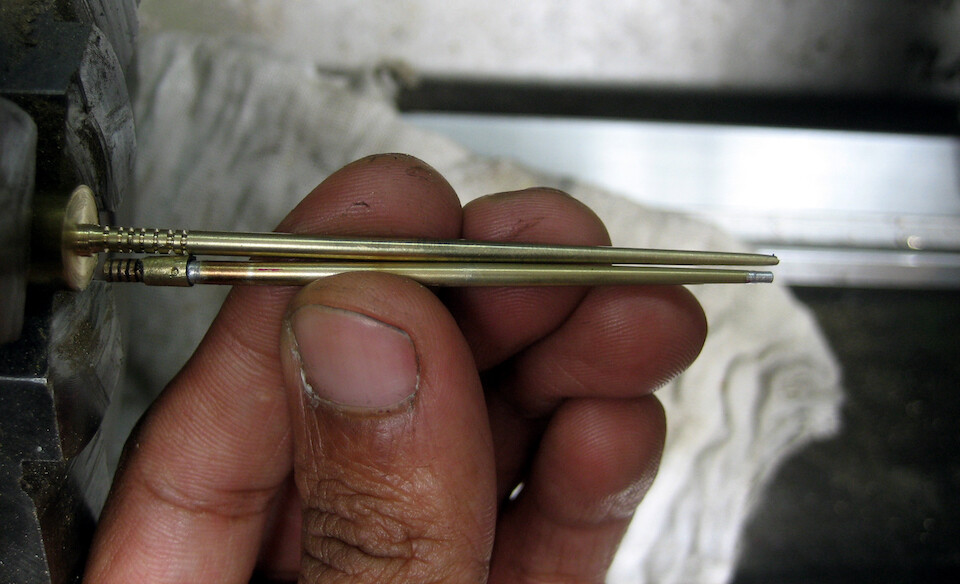
He machined me a new jet needle out of brass to match the profile of my original jet needle as close as possible. The tapered profile of the jet needle is crucial to smooth running of the throttle. But alas, this solution too did not work. I couldn't get the bike to run properly with this new needle. The exact characteristics of the profile could not be matched and these small discrepancies meant my only solution was to put back the shortened original jet needle in the carburetor and order the exact parts from the US. Time to fire up my support network: I called up my mechanic, Gus in Chicago and he ordered the parts right away and sent them to my sister, who FedEx-ed them down to me. The logistics of the situation, with my 90 day Brazilian visa expiring (I spent a whole 3 months in Brazil) and visa extension being a complicated process for me meant that the needle would be best sent to Buenos Aires, where I would meet it in a few weeks time.
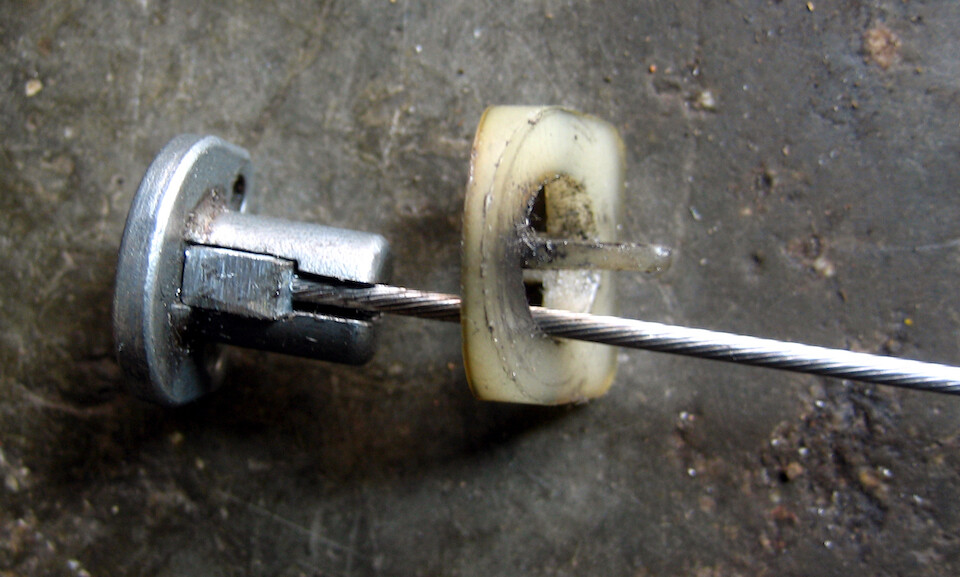
At least I made a new throttle cable and a spare while I was at it.
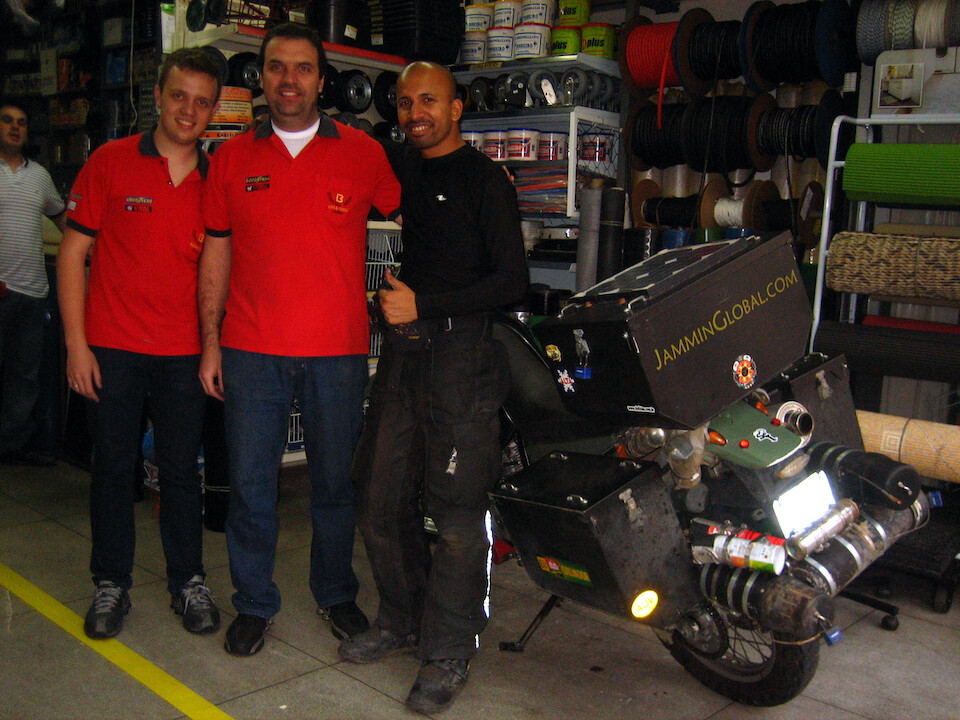
I got some new tool tubes in my care package and went over to friends of Rogerio: Julio and Felipe's hardware shop to source some good hose clamps. When I was ready to pay, the owner Julio said it was on him as he was glad to help a world traveler. He too rides bikes and said he wished he could be doing a trip like mine. The backend of the bike was looking clean now and I thanked Julio for his contribution.
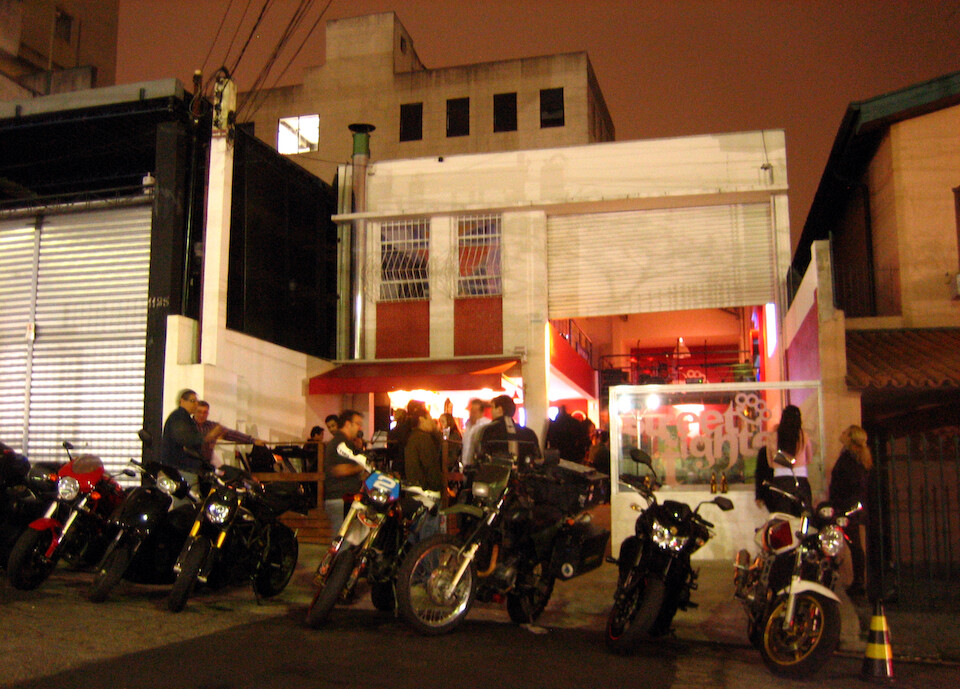
Every Thursday night is a bike night at Street Fighters and the cool thing about the place is that at day it's a motorcycle shop and at night it turns into a happening bar. I think the place is better referred to as a motorcycle boutique. As you might expect, I was standing around answering lots of questions.
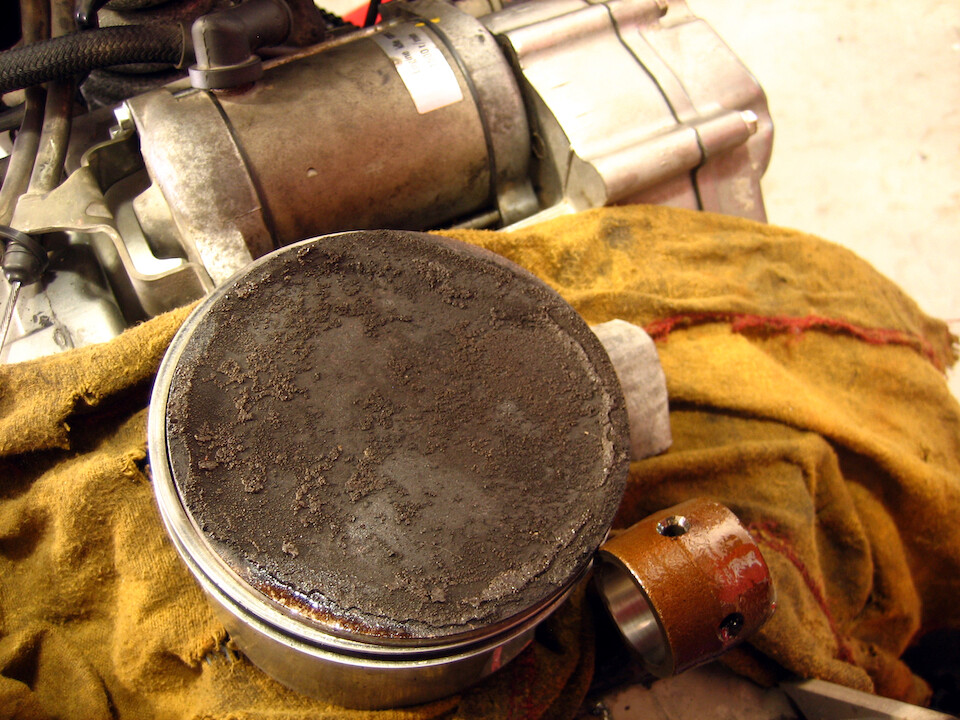
One more day at the shop. In the days leading up to my arrival in São Paulo, on cold starts in the mornings, heavy smoke would billow out of the exhaust for the first few seconds. While not affecting the performance of the bike, I wanted to get it checked out and Rogerio said it was probably my valve stem oil seals seeping oil onto the piston that was being burnt when the engine was cold-started. And since we were removing the cylinder head to service that, might as well go one step further and service the piston. That's carbon buildup on the piston head from over 46,900 kms (29,100 mi) on this engine. However, I think most of that was from the recent very rich running of the carburetor.
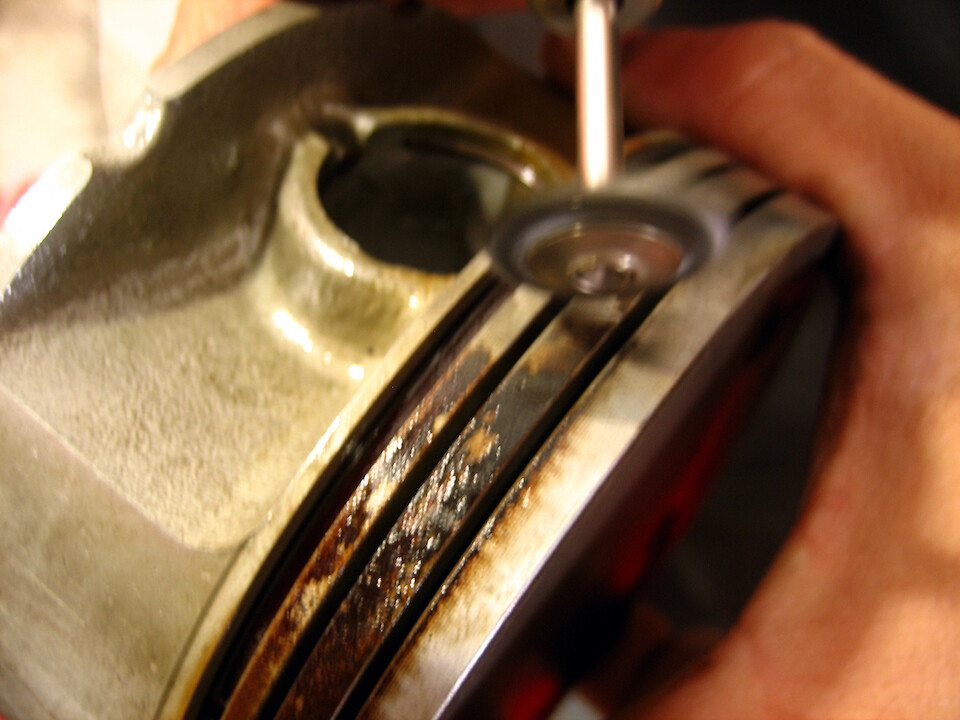
There was a bit of oil blow back past the piston rings (which are tasked with separating the engine oil from the combustion chamber) and since we found an original set of piston rings for my bike at the local Suzuki dealer, might as well change them out now as I don't think I'll be going back into the engine anytime soon (hopefully). Rogerio's running a wire brush here to polish up the surface.
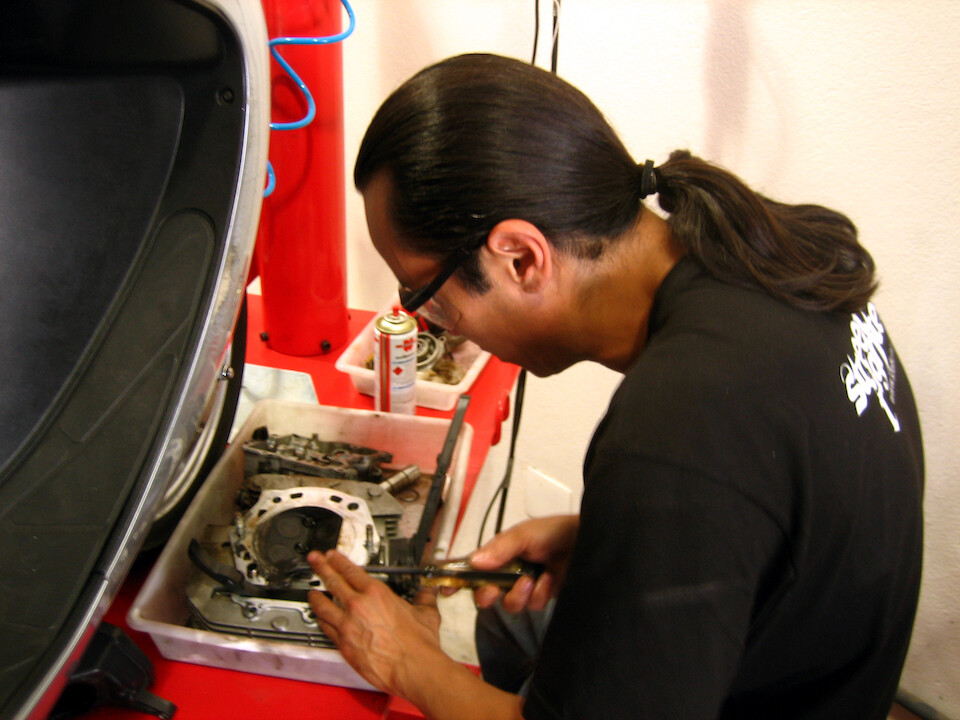
He worked diligently on servicing all the parts. Aware that my previous engine rebuild of my original engine before the trip began lead to its demise (due to my own fault with the cam chain tensioner), I was not deterred of going back into an engine under the expert guidance of Rogerio.
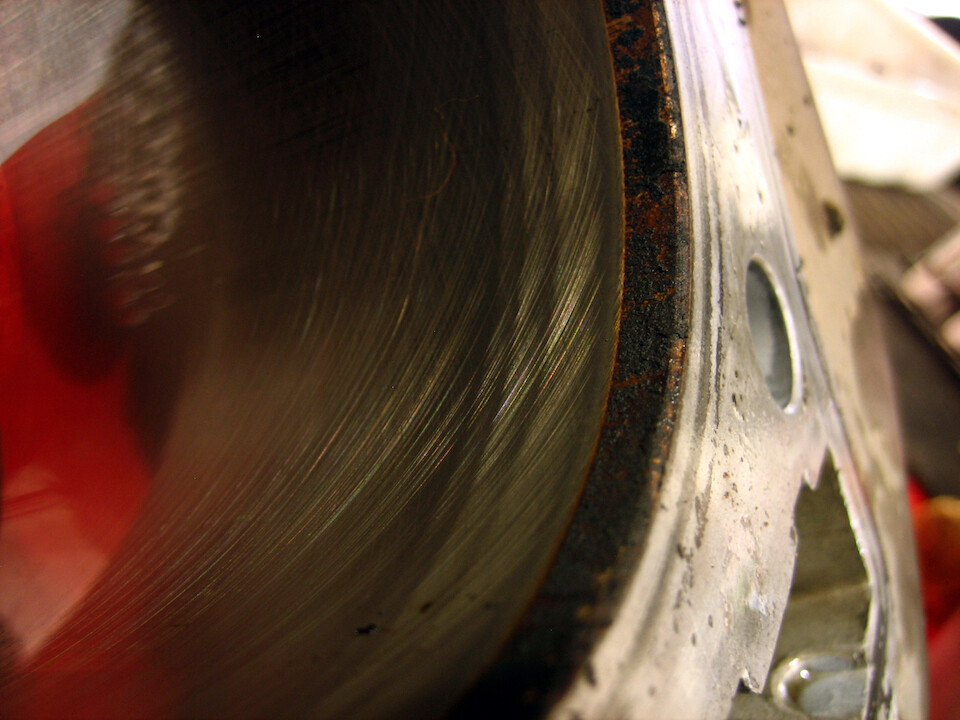
The cross-hatches on the Nikasil coated cylinder walls looking good. This is where the piston slides up and down and the hatches retain oil in them creating a film for smooth piston action.
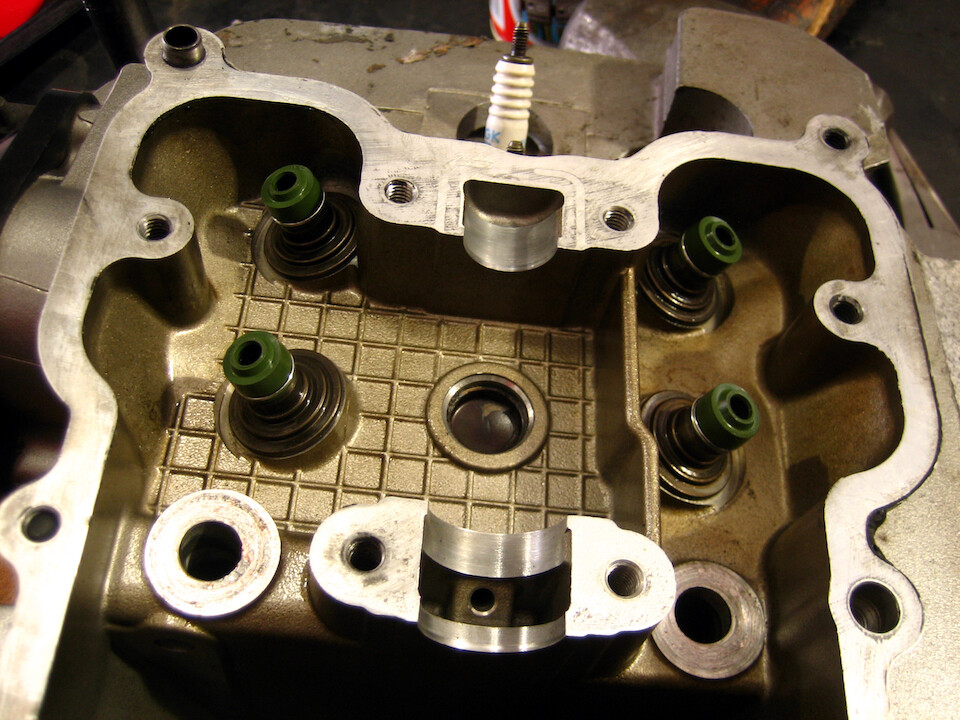
New valve stem oil seals installed (the green parts), which were also conveniently found at the local Suzuki dealer.
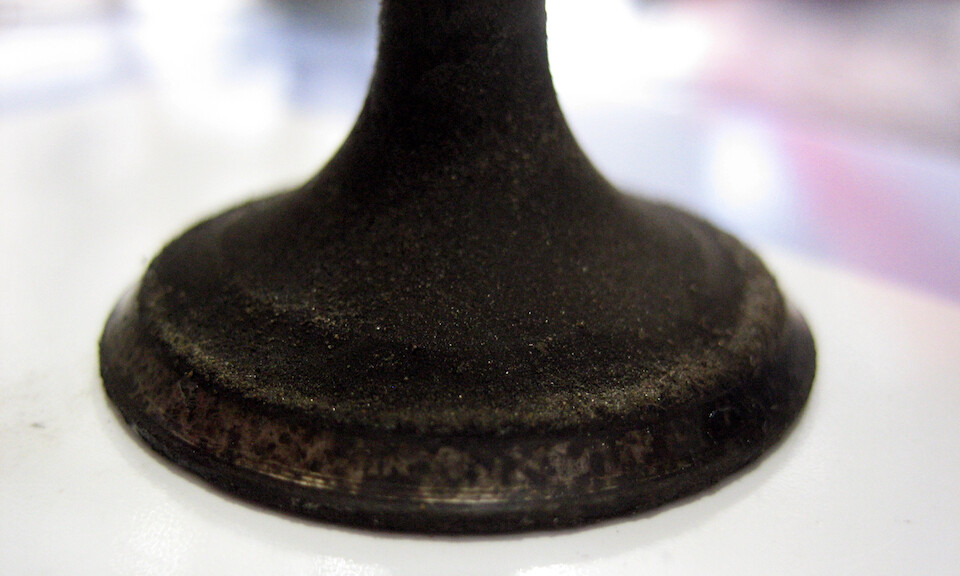
Upon inspecting the valves, Rogerio pointed out the curve that had set in on the valve face. This is an intake valve and the curve meant that when the valve was closed against the cylinder head the seal wasn't perfect and prolonged use would perpetuate the curve and lead to reduced combustion chamber compression pressure (loss of power).
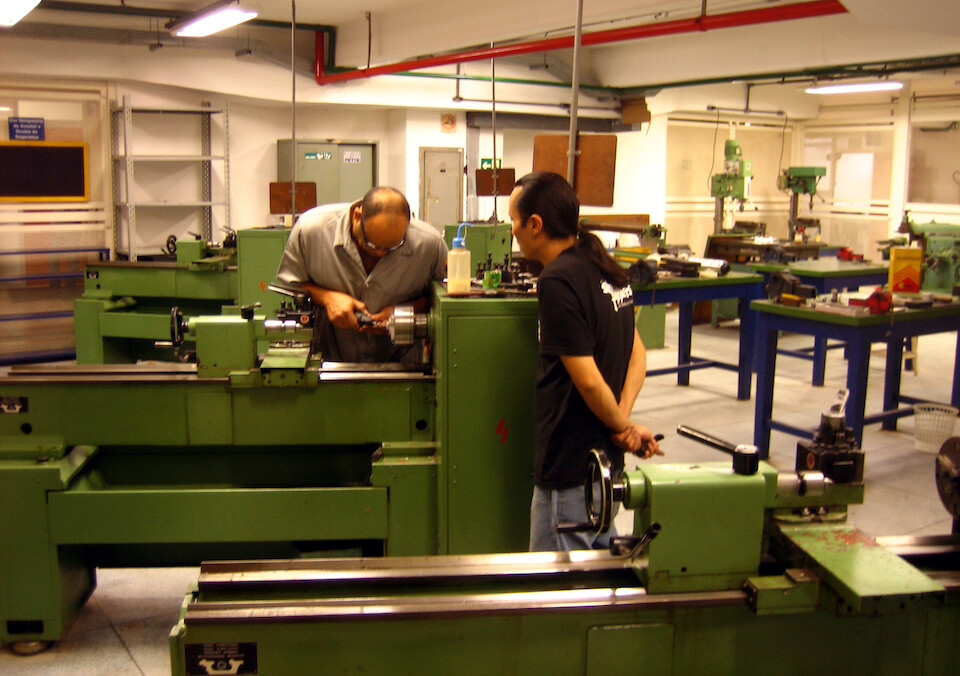
Not finding new valves, we went over to the machine shop at the university with the Formula SAE team and they were happy to help.
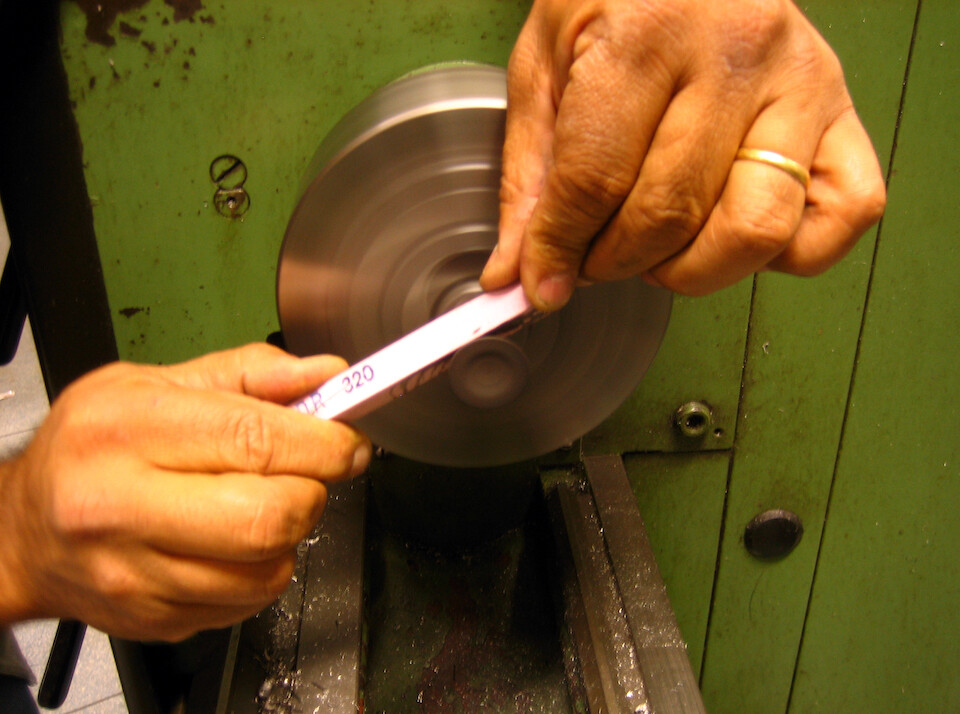
The valve face was slowly grinded flat in a lathe.
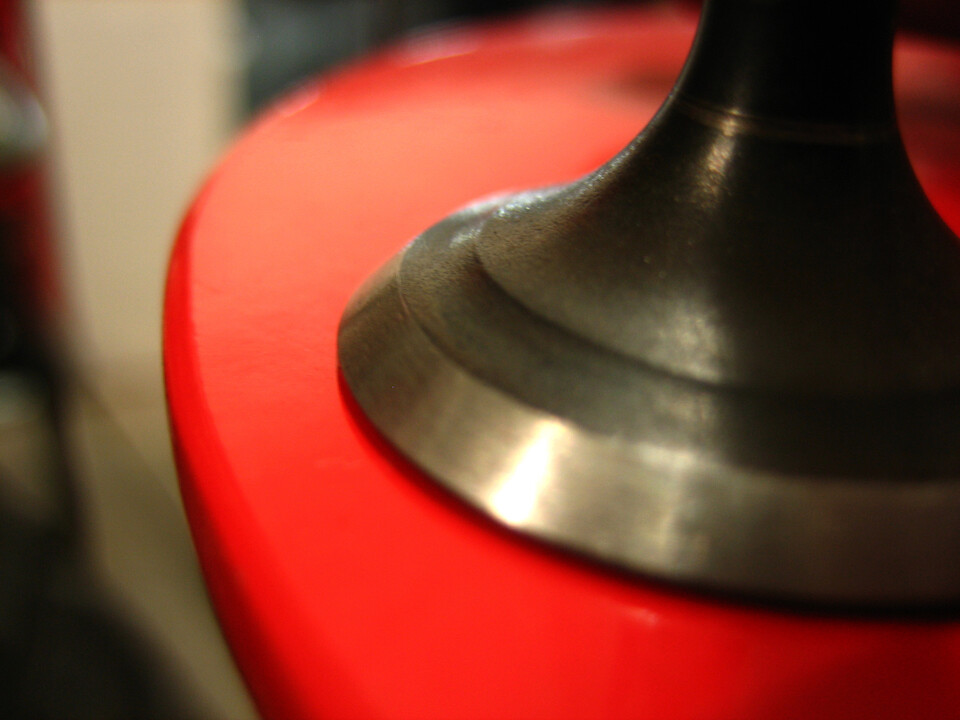
Now that's what a proper valve face is supposed to look like. With the new face, a considerable amount of time was spent re-seating the valves in the cylinder head with a specific grinding paste that ensured the two surfaces mated properly.
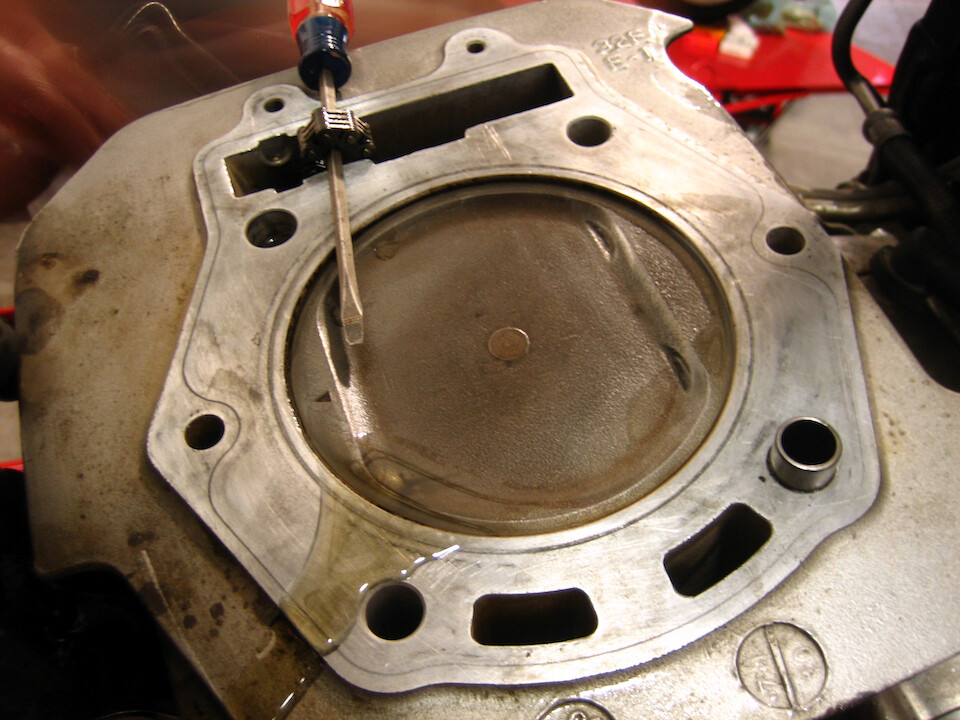
A clean-looking piston back in its home of the engine cylinder. The reassembly of the engine went smoothly and the bike fired up nicely with no smoke on subsequent restarts. sanDRina was feeling fresh all over (rebuilt suspension, top end engine, new bearings, cleaned starter motor, etc), except she was still running the shortened jet needle.
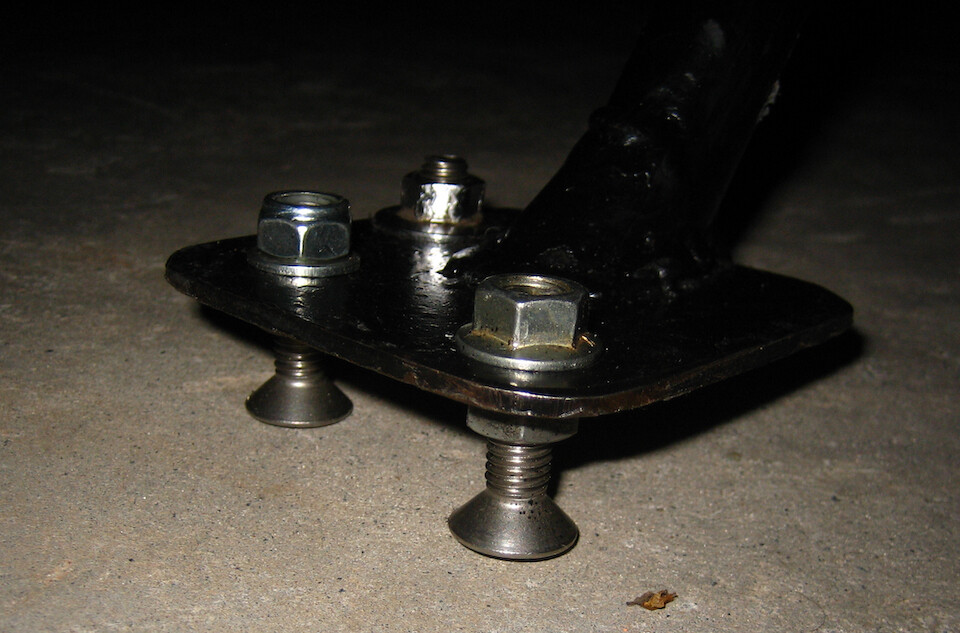
We cranked up the rear spring some more when the shock was rebuilt and this raised the height of the bike and rendered my shortened side stand too short now, so I devised this extension system with three bolts. It would work nicely on hard surfaces but would obviously sink in on loose ground like mud, but placing it on a stone would take care of that.
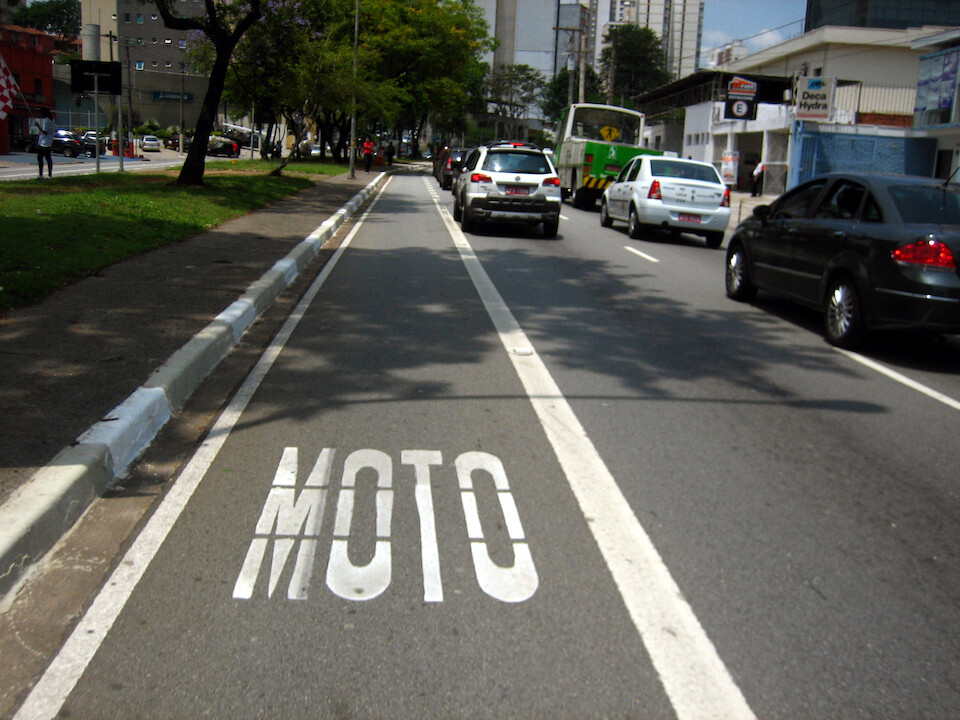
People warned me of the crazy traffic in São Paulo, but it wasn't bad at all. I guess by now I've gotten enough experience of driving through Latin American cities that it comes naturally, that is being aggressive defensive through traffic. But a nice feature of some main routes in São Paulo are these exclusive lanes for motorcycles. Cars are not allowed to stray into this lane and none of them did, making it a breeze during rush hours. This also cuts down on the amount of motorcycles lane-splitting around cars and inadvertently hitting mirrors and scratching doors. I heard the local bikers here, especially the messenger boys, are quite aggressive and will kick mirrors if cars are blocking a path between lanes.
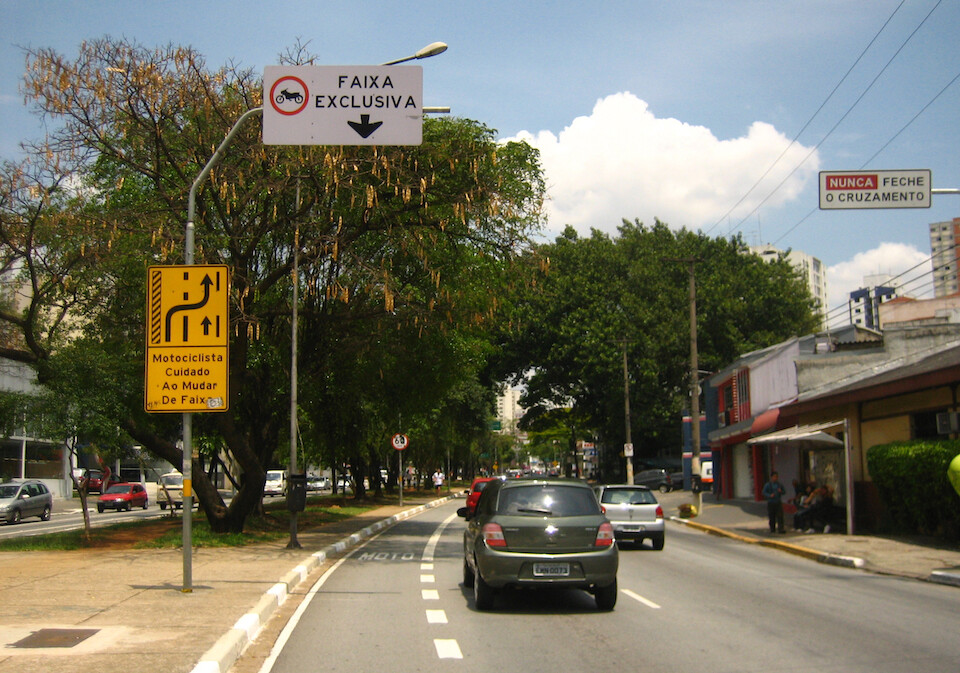
A sign warning bikers to be careful as they cut across lanes near an intersection. Traffic was well-behaved around São Paulo and when there were no exclusive motorcycle lanes, I notched up my lane-splitting experience.
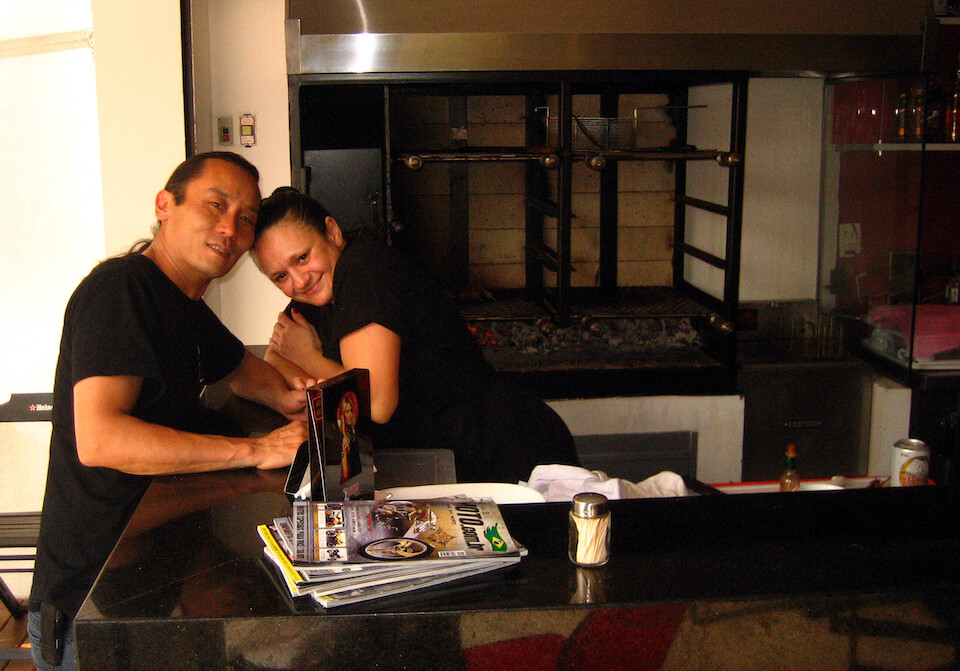
Back at Street Fighters, every Saturday, after closing down the shop at noon, the churrasco (bbq) is fired up and staff and customers enjoy some skewers of beef and chicken with beers and caipirinhas. A big thanks to Rogerio for all the excellent work he did on sanDRina and for teaching me a lot of things along the way.
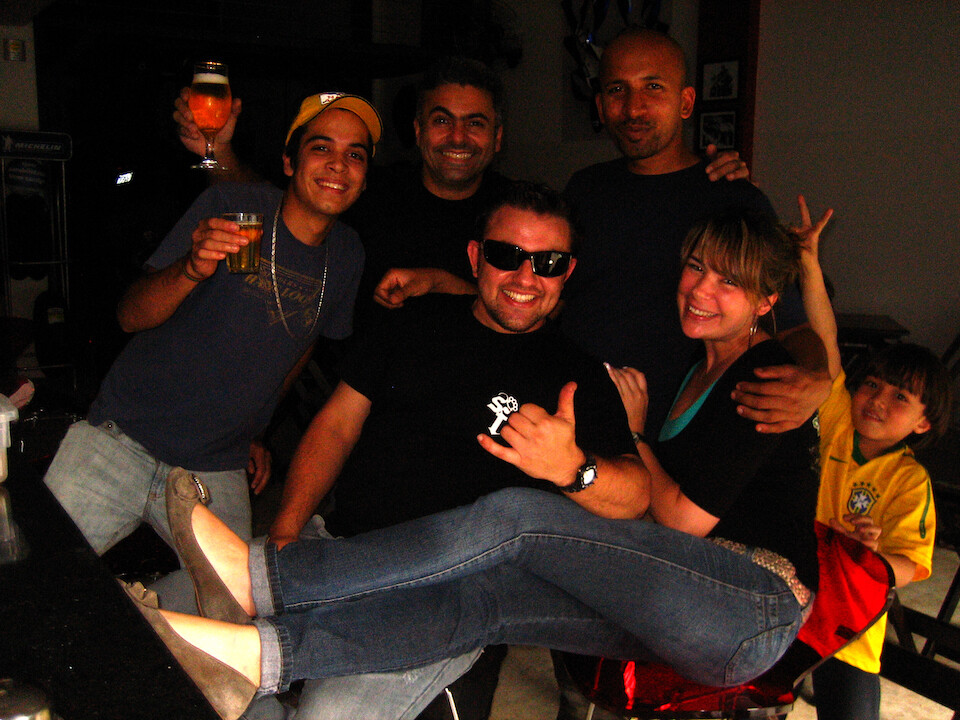
With the crew at Street Fighters. They accepted me as part of the family over the ten days that I kept coming back here. And I thanked them for the heavy discounts they gave me on the work that was done there.
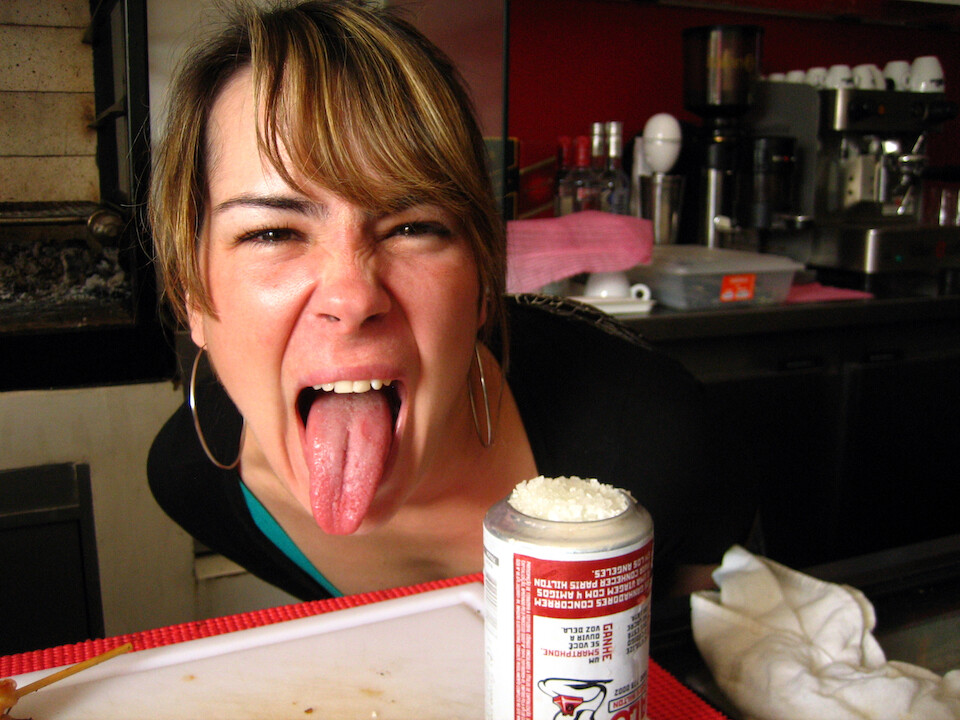
Things got a little crazy. This beer can was inverted and holes were punched in the bottom with rock salt placed on top with another hole for drinking. They do crazy things with beer in each country down here.
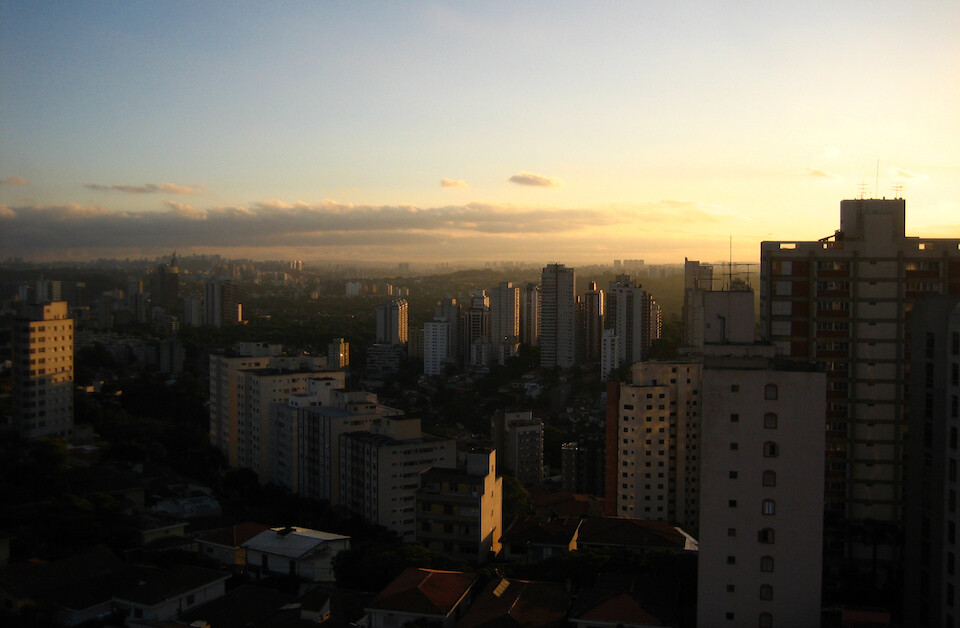
The sun setting over my two weeks in São Paulo. I met many nice Paulistas and got a lot of things taken care of and now it was time to head to the beach and Rio for a bit of R&R.
Next: Brazil, Part 9: Finding paradise in Picinguaba
Previous: Brazil, Part 7: Chapada Diamantina and Minas Gerais